Whole Food Nutrition: The Science Behind Eating for Wellness
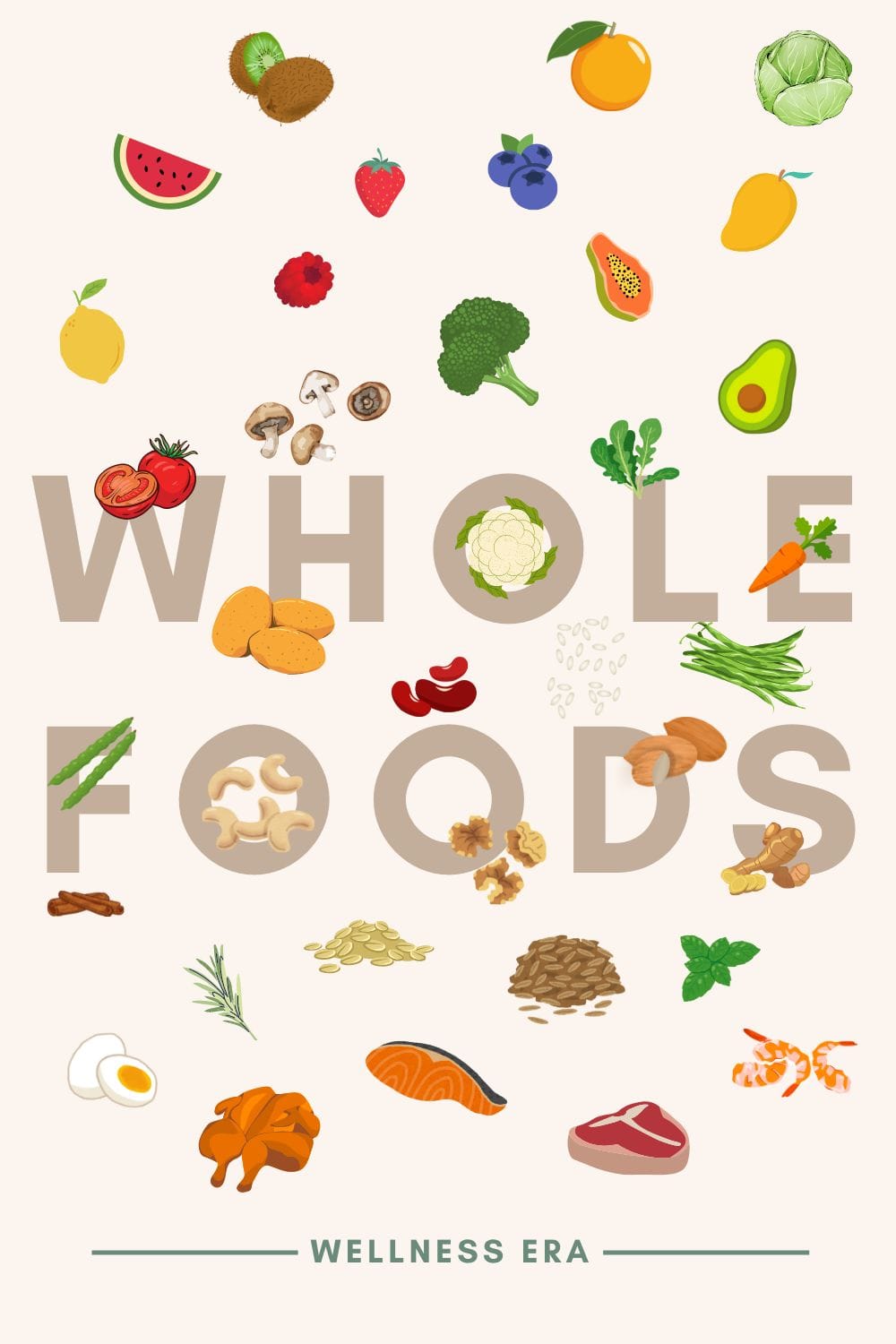
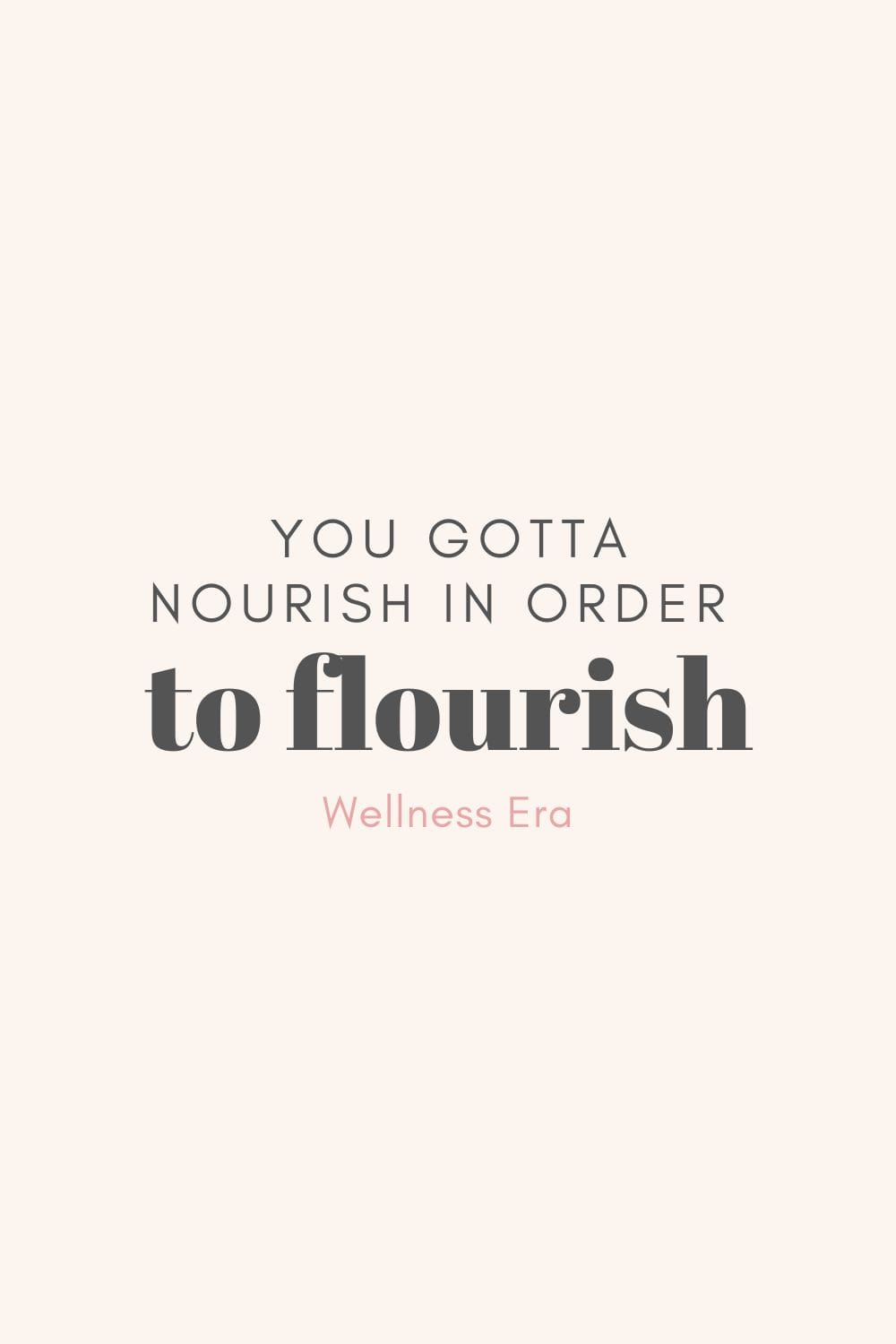
My journey with food has been an evolving one. I started by experimenting with different ways of eating—initially driven by food intolerances that made me rethink everything I put into my body. In the beginning, labeling myself as vegan felt like the easiest way to navigate my intolerances, and it also made me feel like I was contributing to a better environment. But, as time went on, I learned that my relationship with food needed to be more than just about labels.
Through trial and error, I began to (re-)incorporate other nourishing foods into my diet, like eggs, fish, and even grass-fed bone broths. This journey of discovery taught me something fundamental: every bite of food we consume has the potential to nourish us or take away from our health. What we eat isn’t just about fitting into a category; it’s about supporting our bodies in the best way possible.
As I learned more, one thing became clear: whole food nutrition is key to true wellness. Eating whole foods—foods that are as close to their natural state as possible—has the power to heal, energize, and transform our bodies from the inside out. Today, I believe that food isn’t just about personal labels or saving the world; it’s about saving ourselves. When we nourish our bodies properly, we’re in a much better position to help others and make a meaningful impact.
"This blog post is a comprehensive guide to natural skin care and may take some time to read fully. If you'd like to skip ahead, feel free to use the table of contents to jump to the sections that interest you most."
1. What Are Whole Foods? A Simple Definition
Whole foods are foods that are unprocessed or minimally processed, meaning they retain most of their natural form and nutritional value. Think of whole foods as nature’s gift to your body—packed with nutrients, fiber, and antioxidants, without the harmful additives and preservatives that often come with processed foods.
Whole foods include items like fresh fruits and vegetables, whole grains, legumes, nuts, seeds, and minimally processed animal products like eggs, fish, and grass-fed meats. These foods are rich in vitamins, minerals, and other essential nutrients your body needs to thrive.
In contrast, processed foods have been altered in some way, whether through the addition of preservatives, artificial flavors, or chemicals to improve shelf life or taste. Examples include sugary cereals, packaged snacks, processed meats, and soda. These foods are often stripped of their nutrients and filled with unhealthy additives that can harm your health over time.
By focusing on whole foods, you’re giving your body the building blocks it needs to function optimally—helping you feel more energized, improve digestion, and reduce the risk of chronic diseases. Simply put, whole foods nourish your body the way nature intended.
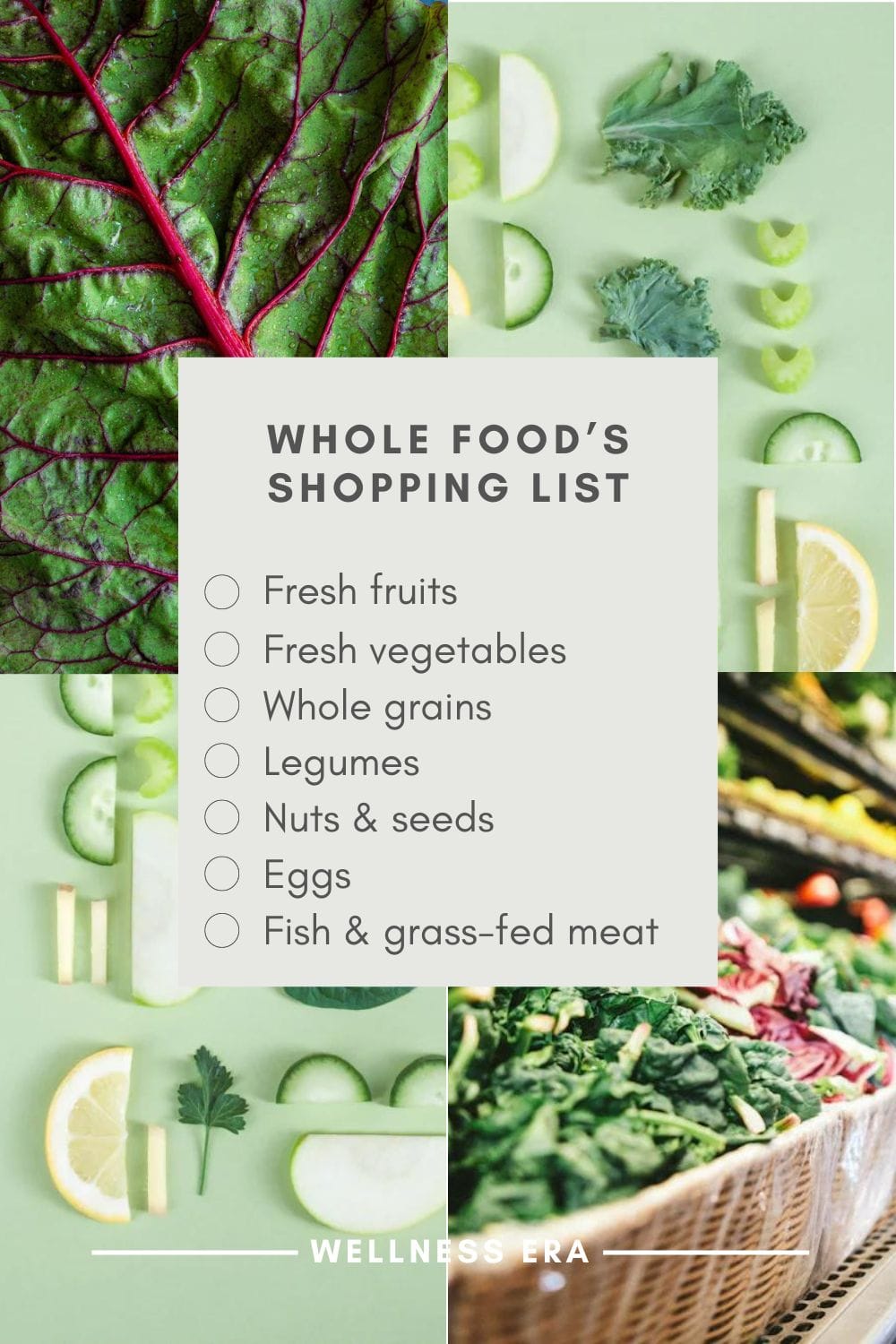
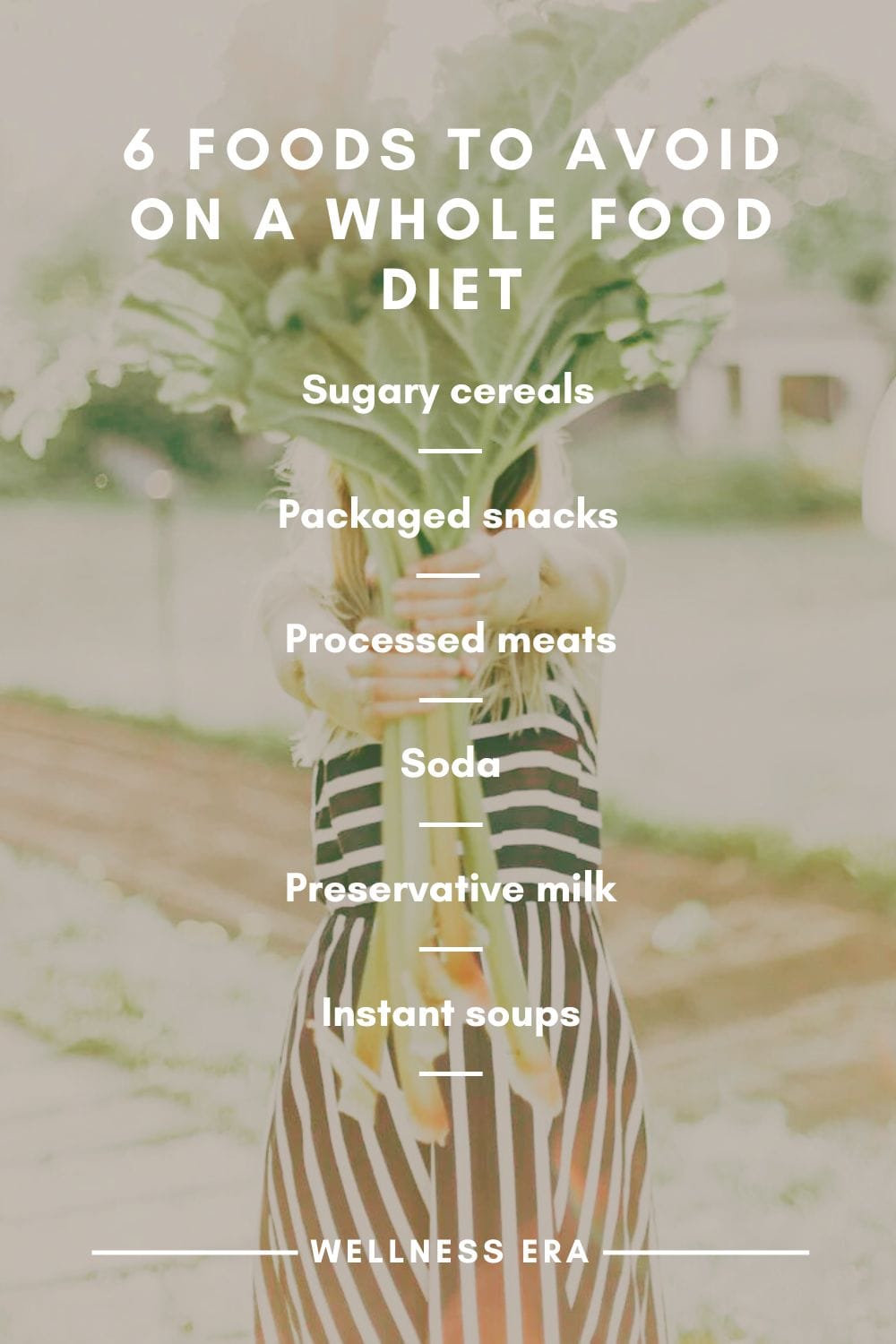
2. The Science Behind Whole Food Nutrition
The beauty of whole food nutrition lies not just in its ability to prevent chronic diseases, but also in its incredible impact on how we look and feel. When we nourish our bodies with real, unprocessed foods, we’re not only supporting long-term health, but also enhancing the appearance of our skin, hair, nails, and overall body composition.
Whole foods, particularly fruits, vegetables, whole grains, and healthy fats, are packed with antioxidants, vitamins, and minerals that play crucial roles in maintaining cellular health. For instance, antioxidants found in fruits like berries and vegetables like spinach help fight oxidative stress, which can damage skin cells and lead to premature aging (Nimse & Pal, 2015). A diet rich in whole foods is like a natural anti-aging treatment for your skin, helping it stay firm, radiant, and hydrated.
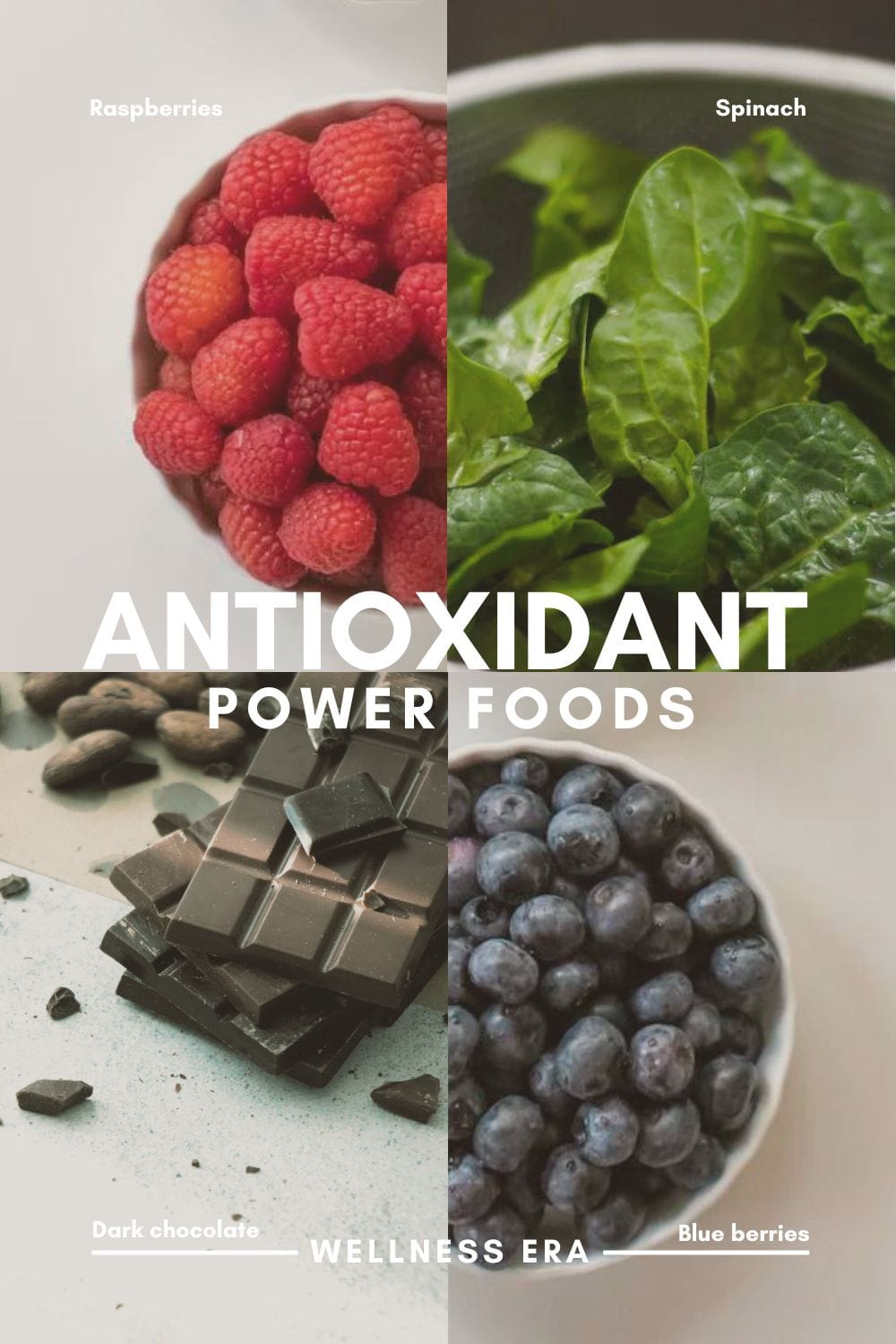
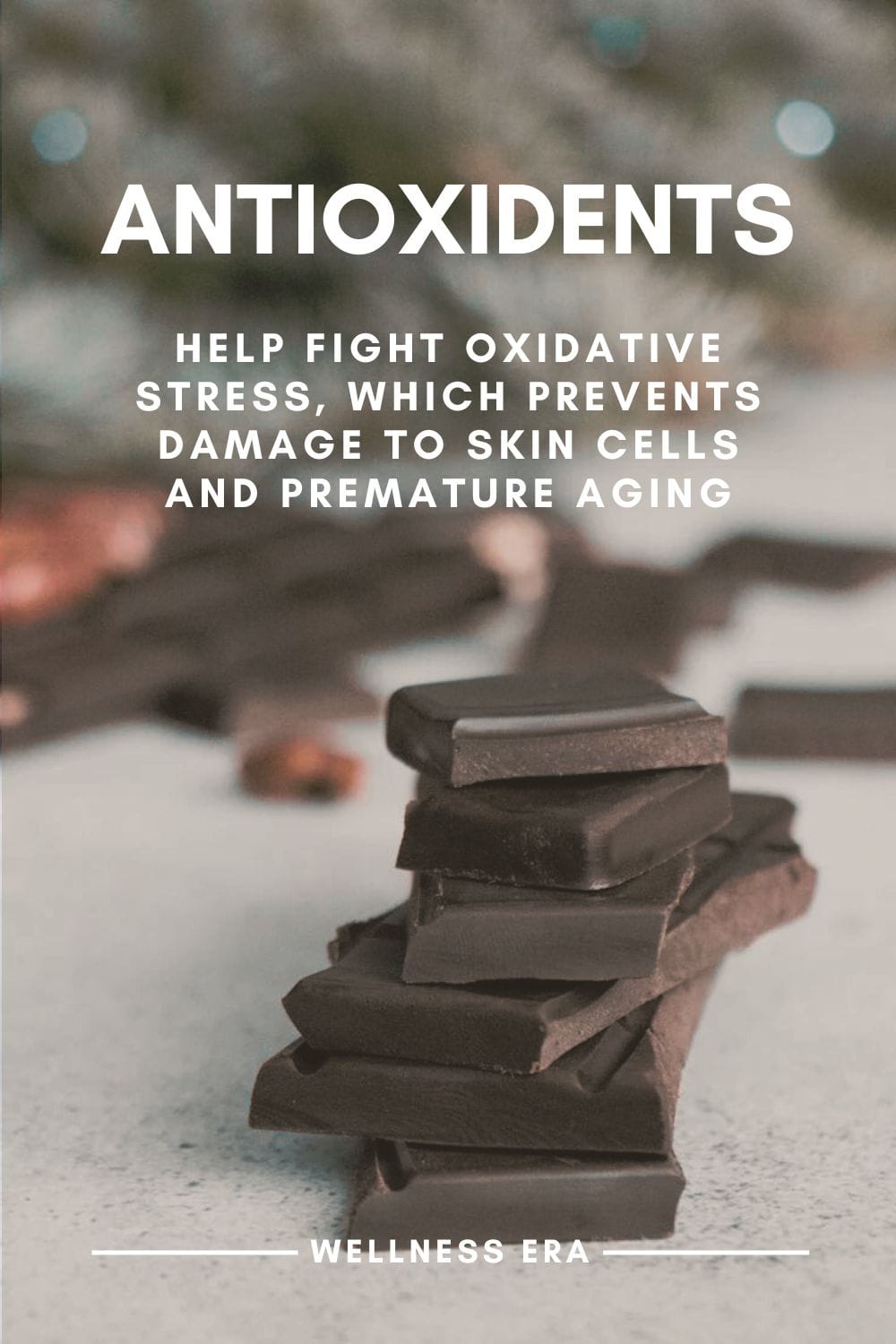
Healthy fats, such as those found in avocados, nuts, and fatty fish, are essential for maintaining the elasticity of your skin, keeping it hydrated, and promoting a glowing complexion. Omega-3 fatty acids, in particular, are known to reduce inflammation, which can help with conditions like acne and eczema (Simopoulos, 2002). These healthy fats also support strong, shiny hair and healthy nails.
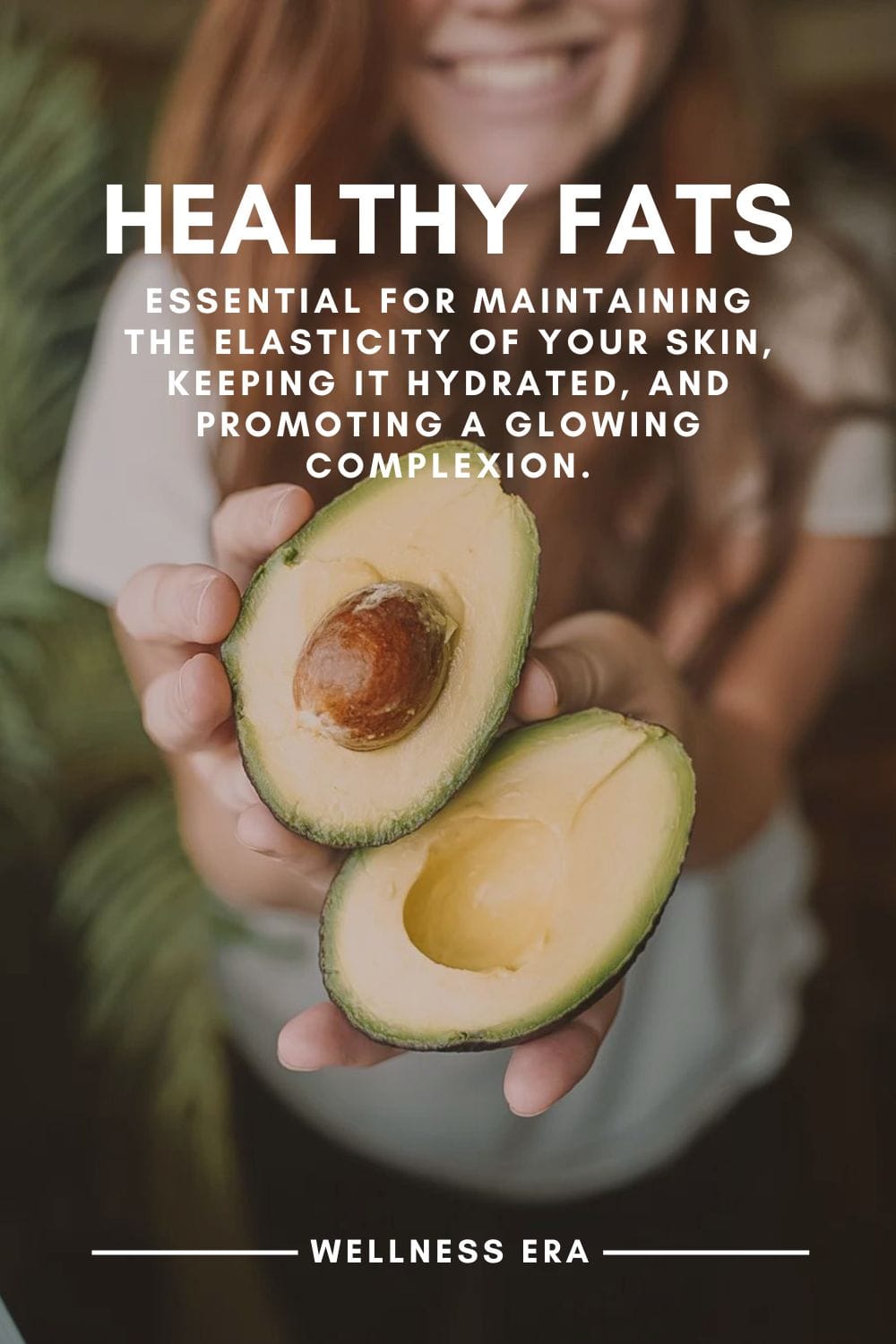
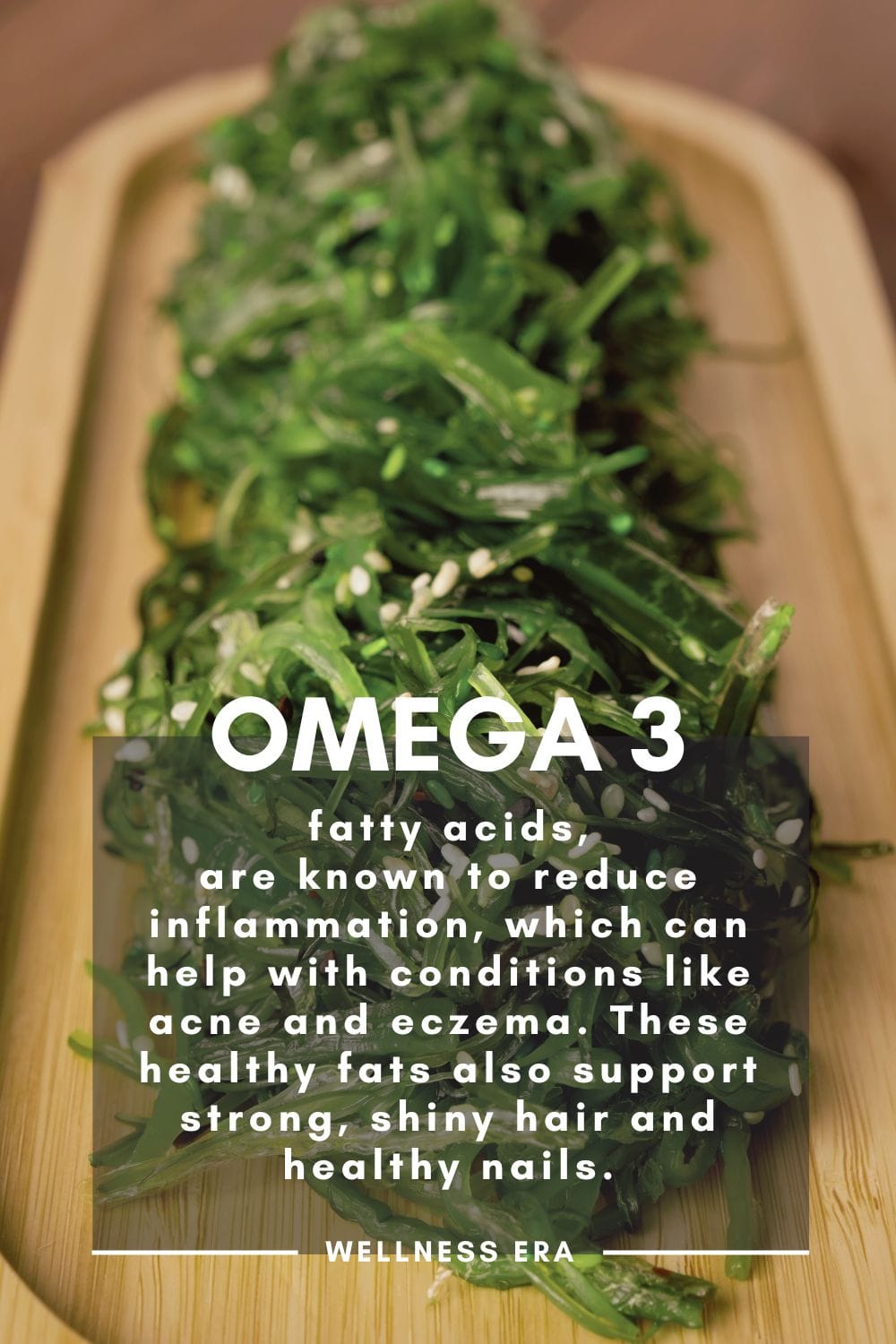
Vitamins and minerals from whole foods are essential for healthy body composition. Foods rich in biotin (found in eggs, nuts, and seeds) and vitamin C (found in citrus fruits and leafy greens) are key for collagen production, which keeps your skin firm and promotes strong hair and nails (Pongcharoen et al., 2016). Whole grains and legumes, rich in zinc, support tissue growth and repair, while also contributing to a healthy metabolism.
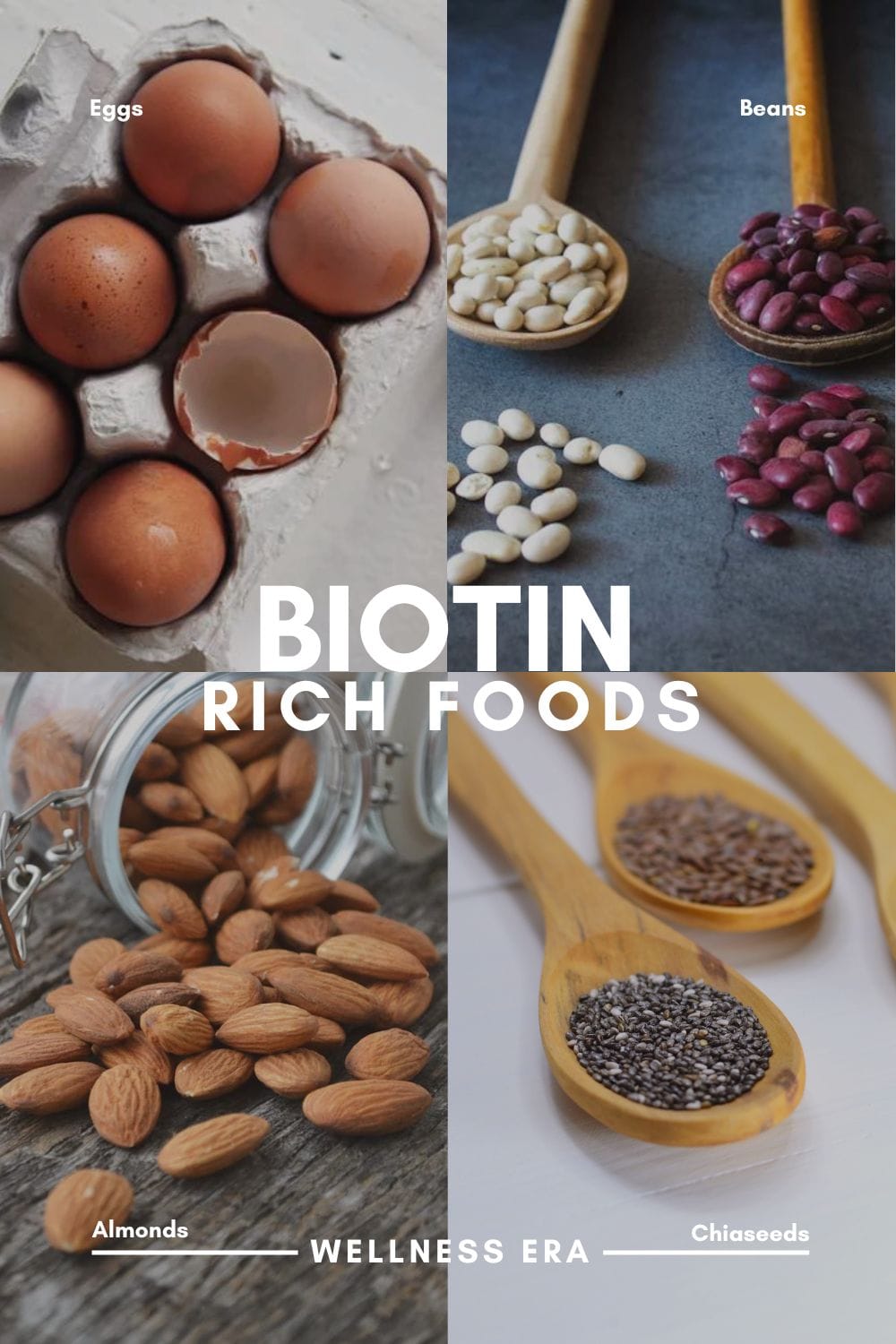
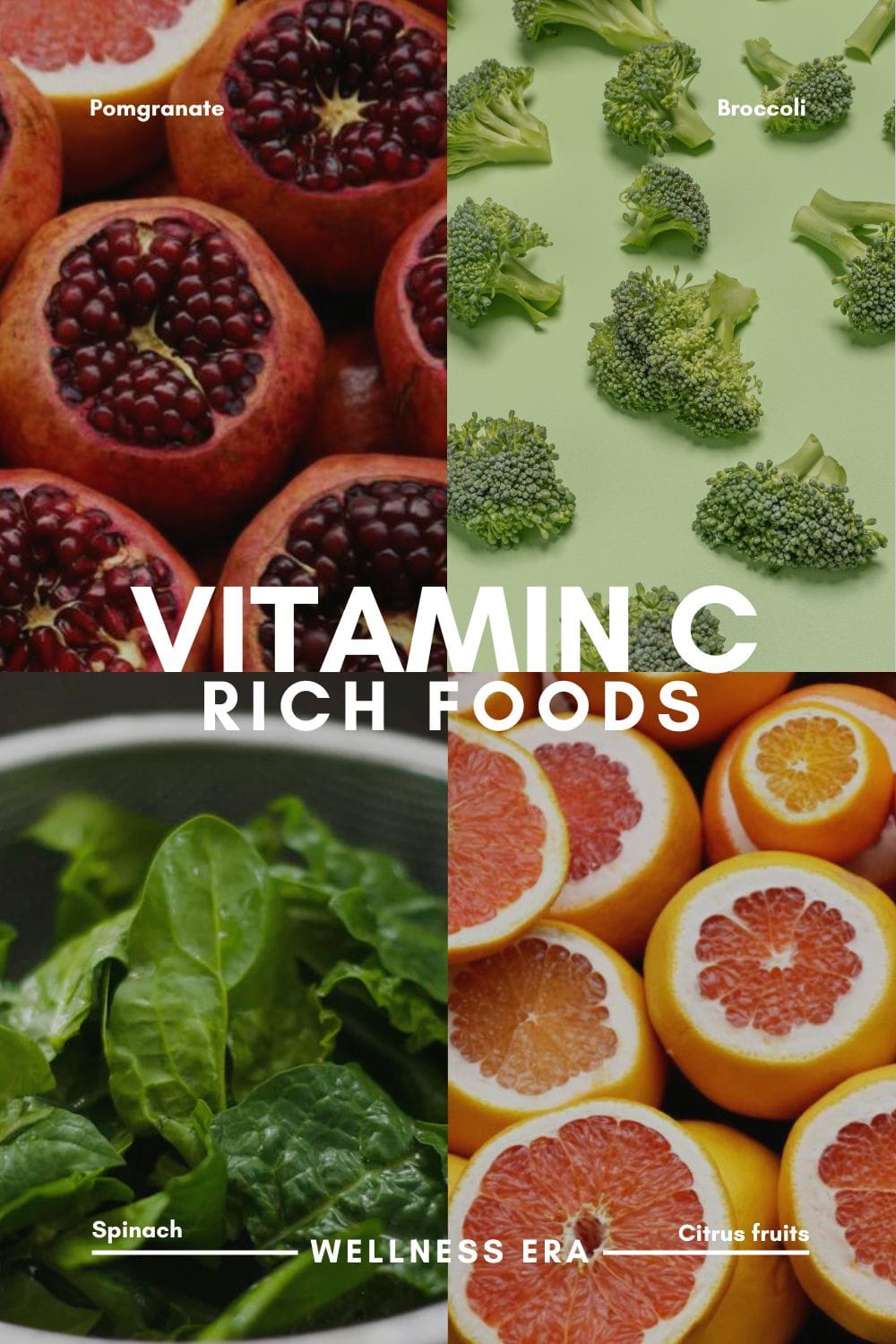
Furthermore, whole foods are high in fiber, which not only aids digestion but also helps regulate blood sugar levels, keeping your energy stable and supporting a lean, healthy body composition. Fiber-rich foods like vegetables, legumes, and whole grains can even aid in weight management by promoting a feeling of fullness and supporting healthy gut bacteria, which are linked to overall wellness and body health (Slavin, 2013).
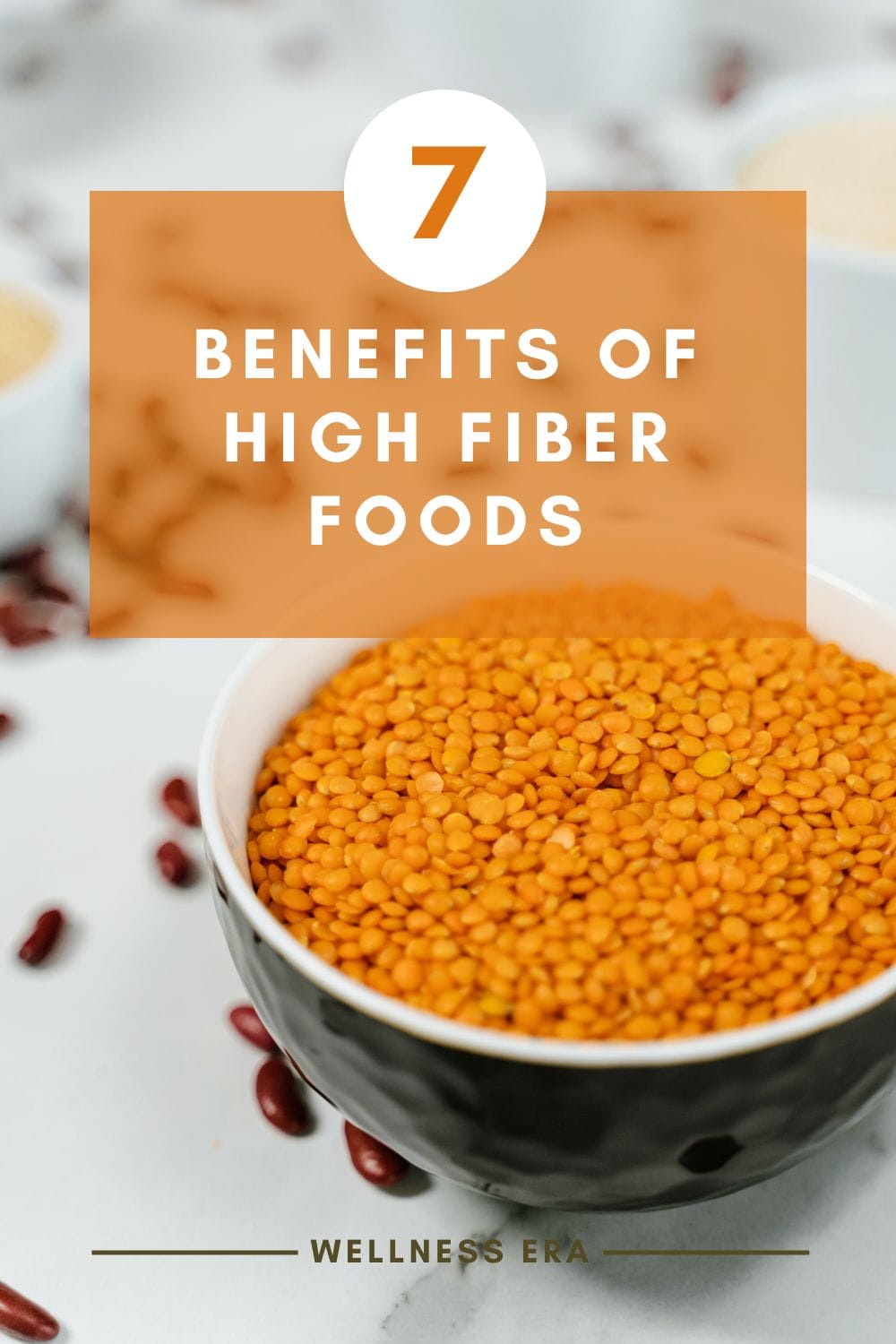
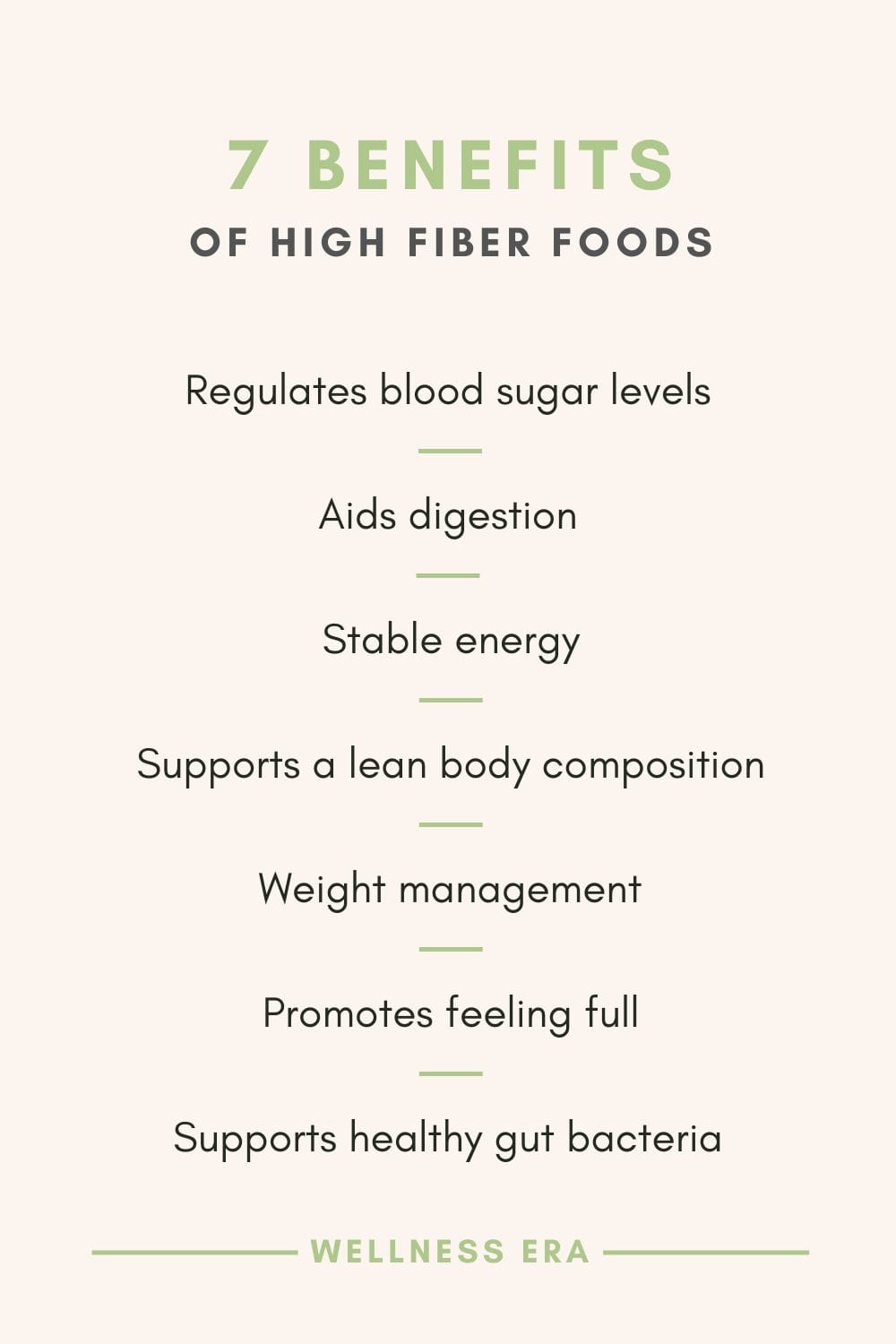
In short, the science behind whole food nutrition is clear: a diet focused on whole, unprocessed foods can do wonders not only for your internal health but also for your outward appearance, helping you look and feel your best from the inside out.
References
Nimse, S.B. and Pal, D., 2015. Free radicals, natural antioxidants, and their reaction mechanisms. RSC Advances, 5(35), pp.27986-28006.
Simopoulos, A.P., 2002. Omega-3 fatty acids in inflammation and autoimmune diseases. Journal of the American College of Nutrition, 21(6), pp.495-505.
Pongcharoen, S., Wanachantararak, P. and Chaithirayanon, K., 2016. Biotin and vitamin C serum levels and hair loss. Journal of Cosmetic Dermatology, 15(3), pp.214-221.
Slavin, J.L., 2013. Fiber and prebiotics: mechanisms and health benefits. Nutrients, 5(4), pp.1417-1435.
3. Processed Food vs. Whole Foods: What’s Really in Our Food?
When we talk about whole foods vs. processed foods, it’s important to understand what’s really in our food and how it impacts our health and appearance. Processed foods, which are often altered from their natural state, contain additives and chemicals that are designed to enhance flavor, shelf life, and texture, but these modifications come at a cost.
Processed foods—such as sugary snacks, refined grains, and pre-packaged meals—are often stripped of their natural nutrients during manufacturing. They’re commonly packed with refined sugars, unhealthy fats, and artificial preservatives, all of which can lead to a wide range of health issues like weight gain, inflammation, and even skin problems (Monteiro et al., 2018). The refined sugars found in processed foods can accelerate the breakdown of collagen in your skin, leading to wrinkles and dullness (Danby, 2010). Additionally, trans fats and unhealthy oils found in processed snacks and fried foods can contribute to inflammation, potentially worsening acne and other skin conditions (Smith et al., 2016).
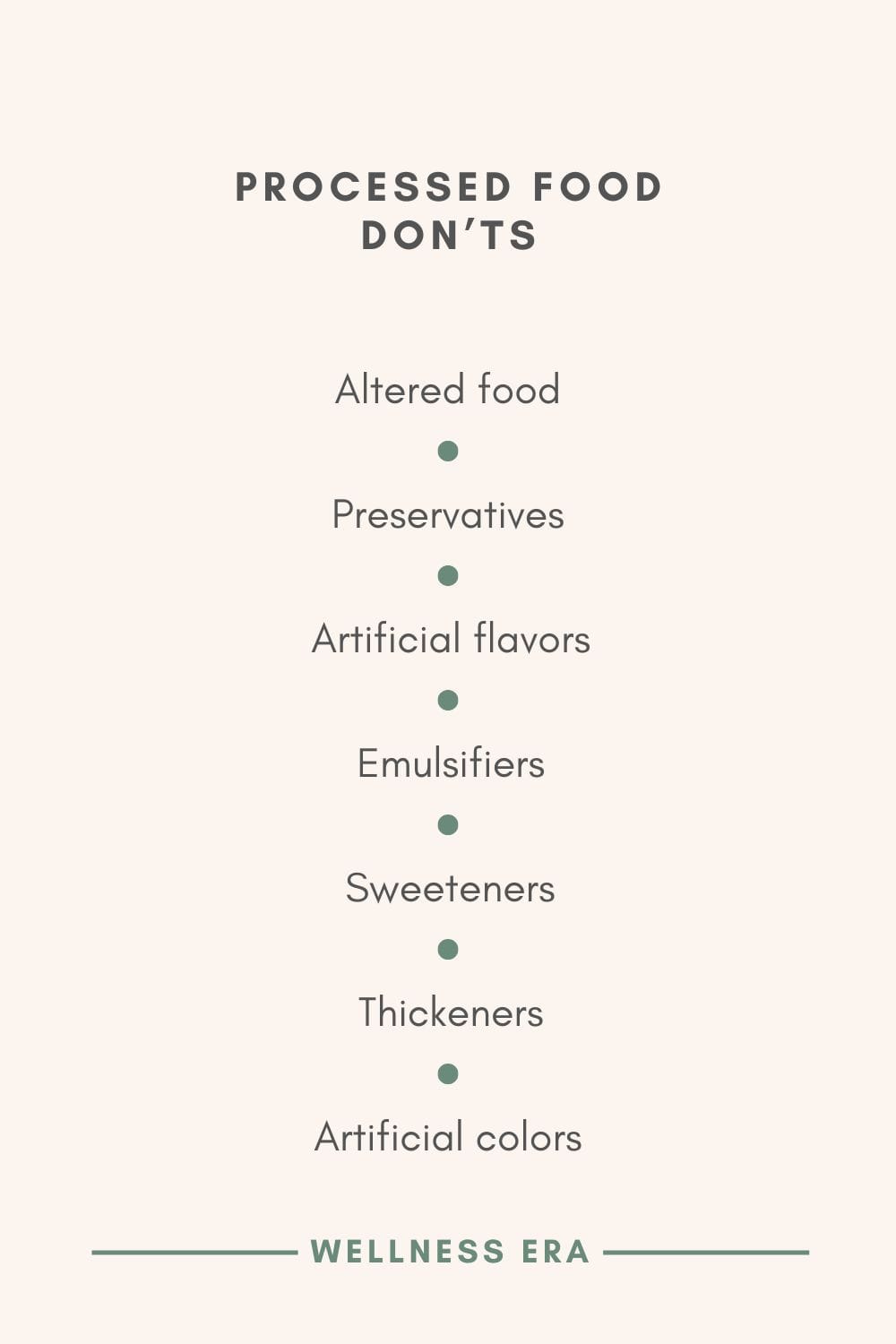
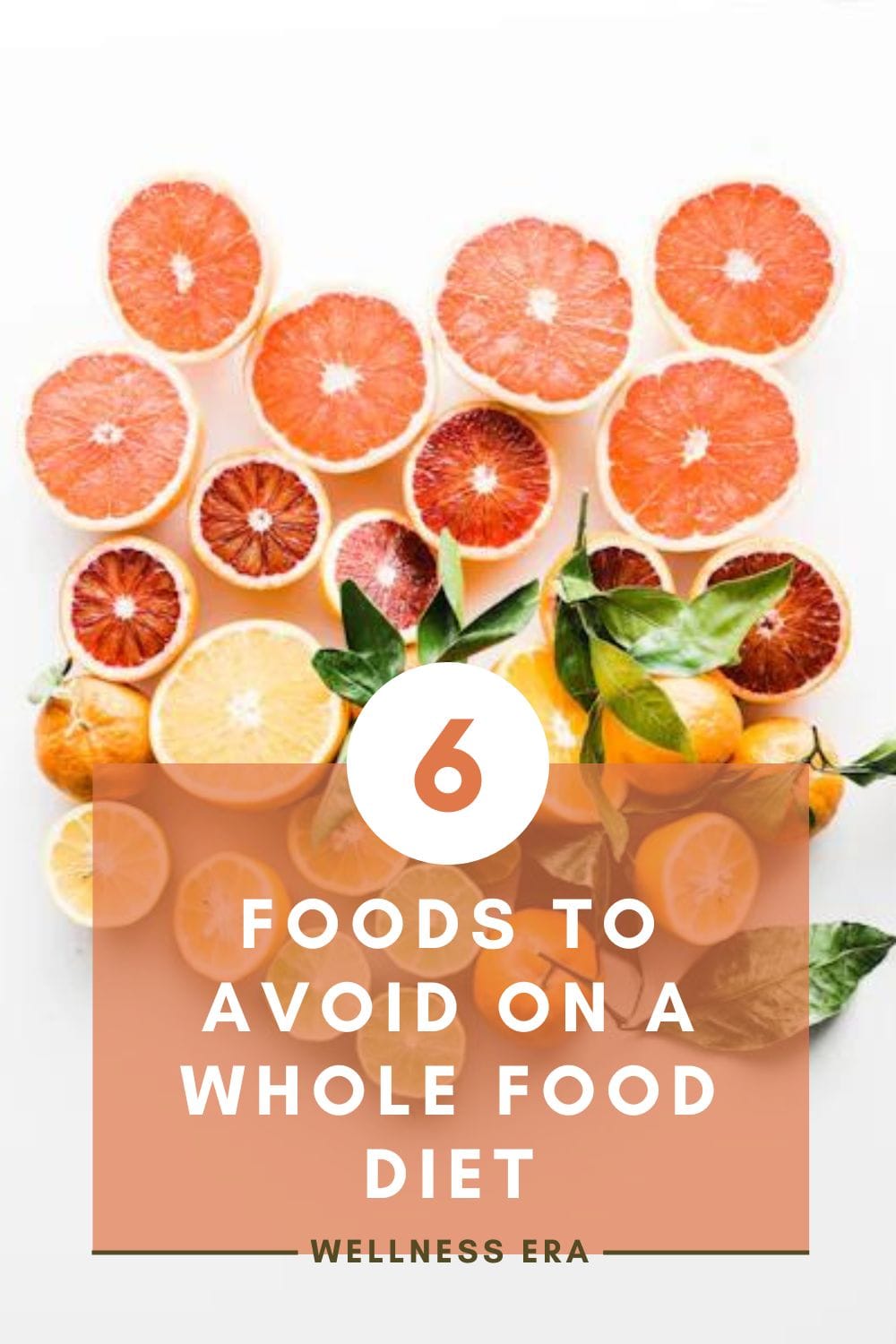
In contrast, whole foods—like fresh vegetables, fruits, lean proteins, and whole grains—are rich in the nutrients your body needs to thrive. These foods naturally contain vitamins, minerals, antioxidants, and fiber, which help to regulate bodily processes, including those that affect the health of your skin, hair, and nails.
For example, leafy greens like spinach and kale are packed with vitamin A, which is essential for skin regeneration and healing (Melnik, 2012). Eating whole grains like quinoa and brown rice provides your body with B vitamins that support energy production and cell metabolism, leading to healthier hair and skin. These nutrient-dense foods are also high in fiber, which aids digestion, balances blood sugar, and supports a healthy weight.
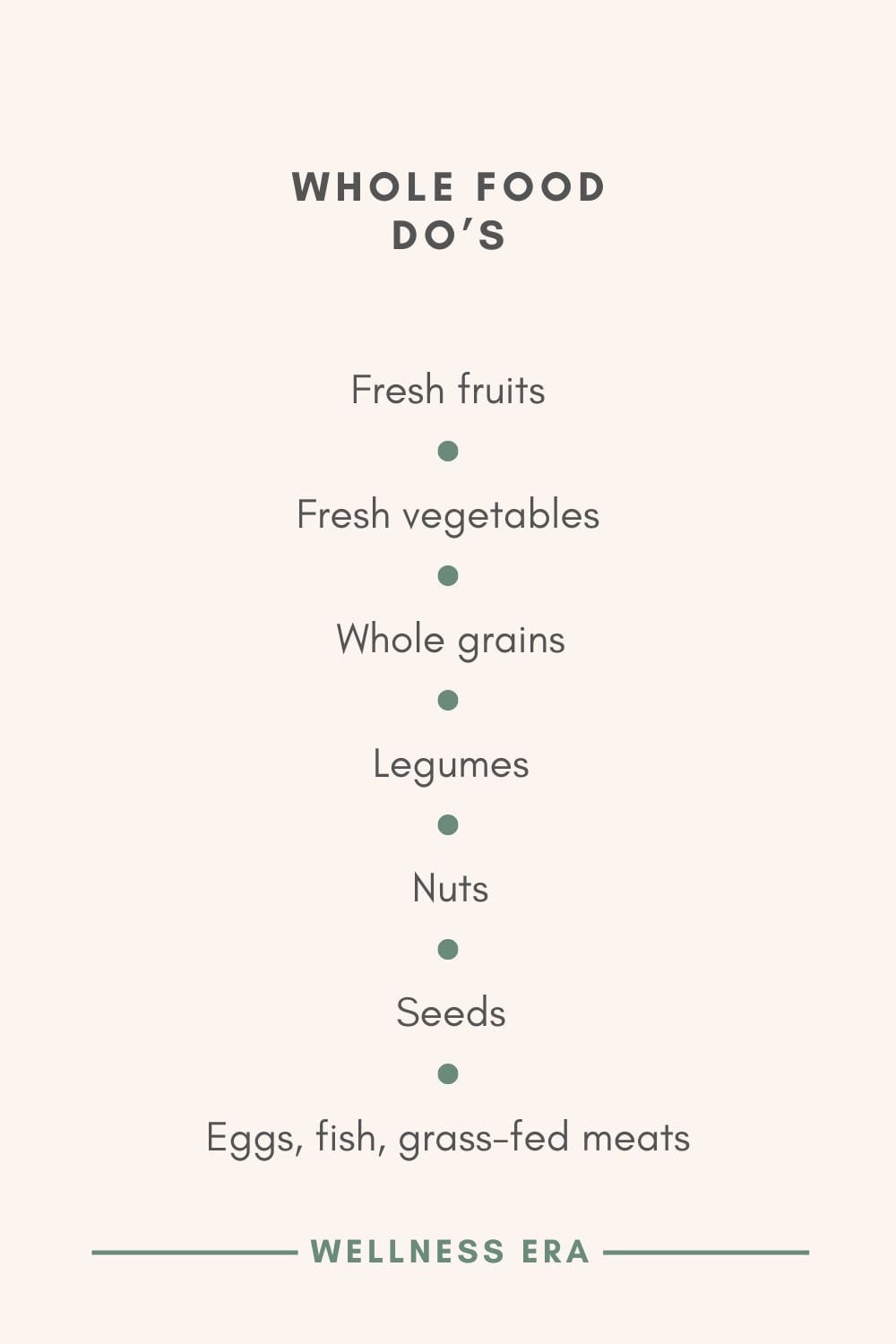
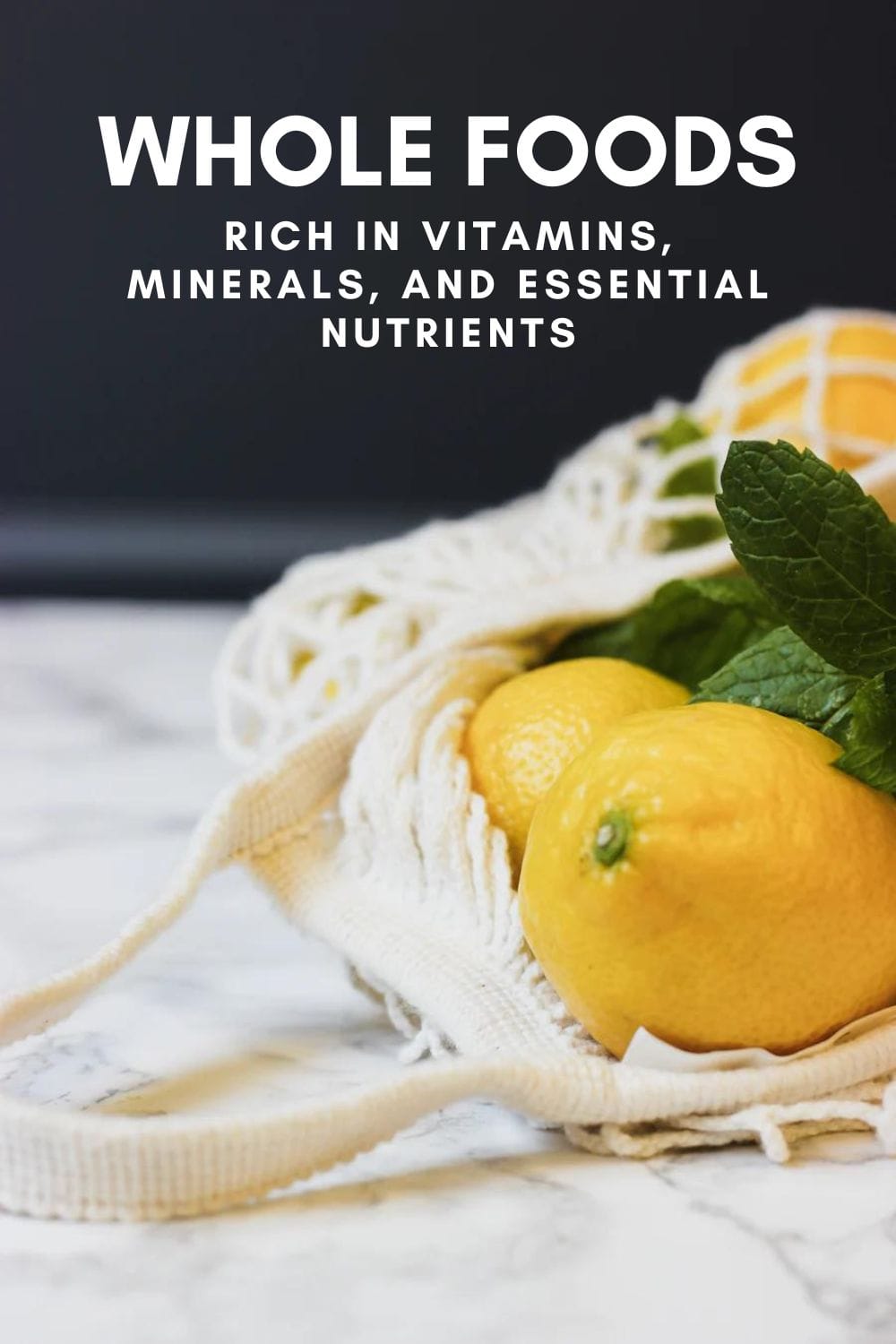
Why are processed foods filled with additives?
The food industry uses additives like preservatives, artificial flavors, and emulsifiers to make products last longer and taste better, but these additives do little to nourish your body. In fact, they often replace the real, nutrient-dense components of food. The result is food that may be convenient, but it lacks the nutrients your body needs to stay healthy, both inside and out.
By switching to a diet rich in whole foods, you’re not just avoiding the harmful effects of processed food, but you’re also feeding your body the nutrients it craves to function optimally. The result? Better skin, healthier hair, stronger nails, and a leaner, more energized body.
References
Monteiro, C.A., Cannon, G., Moubarac, J.C., Levy, R.B., Louzada, M.L. and Jaime, P.C., 2018. Ultra-processed foods: what they are and how to identify them. Public Health Nutrition, 22(5), pp.936-941.
Danby, F.W., 2010. Nutrition and aging skin: sugar and glycation. Clinics in Dermatology, 28(4), pp.409-411.
Smith, R.N., Mann, N.J., Braue, A., Mäkeläinen, H. and Varigos, G.A., 2016. A low-glycemic-load diet improves symptoms in acne vulgaris patients: a randomized controlled trial. American Journal of Clinical Nutrition, 86(1), pp.107-115.
Melnik, B.C., 2012. Dietary intervention in acne: Attenuation of increased mTORC1 signaling promoted by Western diet. Dermato-Endocrinology, 4(1), pp.20-32.
4. Top 5 Benefits of Eating Whole Foods
Whole food nutrition offers a wide range of benefits that go beyond just feeling good—it’s about nurturing your body from the inside out. Here are the top five benefits of making whole foods a priority in your diet:
1. Better Skin, Hair, and Nails
Whole foods provide your body with the essential vitamins and minerals needed for healthy skin, hair, and nails. Foods rich in vitamin E, like almonds and sunflower seeds, help protect your skin from oxidative stress and keep it hydrated. Meanwhile, biotin, found in eggs and nuts, strengthens hair and nails, promoting growth and preventing brittleness (Pongcharoen et al., 2016).
2. Increased Energy Levels
Whole foods, such as whole grains, fruits, and vegetables, deliver a steady source of energy throughout the day, thanks to their high fiber content and complex carbohydrates. These foods help maintain stable blood sugar levels, preventing the energy crashes often associated with processed foods (Slavin, 2013).
3. Improved Digestion
Whole foods, particularly those high in fiber like vegetables, legumes, and whole grains, promote healthy digestion by supporting the growth of beneficial gut bacteria. A diet rich in fiber can help prevent constipation, reduce bloating, and even support a healthy metabolism (Slavin, 2013).
4. Stronger Immunity
Nutrient-dense whole foods like berries, leafy greens, and citrus fruits are loaded with antioxidants and vitamins, such as vitamin C, which help strengthen your immune system. These nutrients protect your cells from damage and inflammation, keeping your body better equipped to fight off infections (Nimse & Pal, 2015).
5. Enhanced Body Composition
Whole foods promote a healthy metabolism and body composition by providing nutrients without the excess sugars, unhealthy fats, and empty calories found in processed foods. High-protein whole foods like lean meats, eggs, and legumes help build muscle, while fiber-rich foods promote a healthy weight by keeping you full and satisfied longer.
Eating whole foods isn’t just about preventing disease—it’s also about looking and feeling your best every day. By filling your plate with nutrient-dense options, you’ll notice the benefits in everything from your skin to your energy levels.
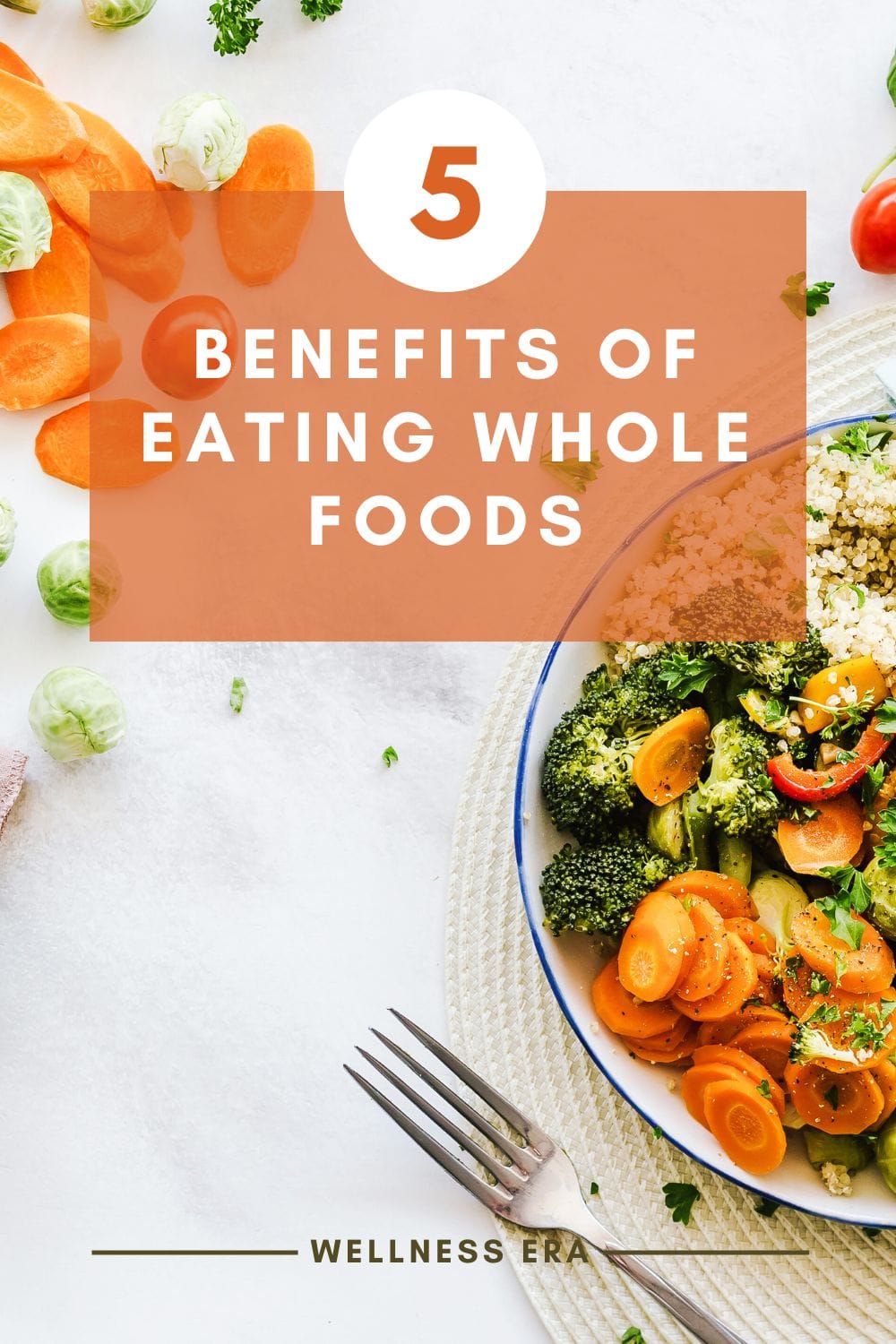
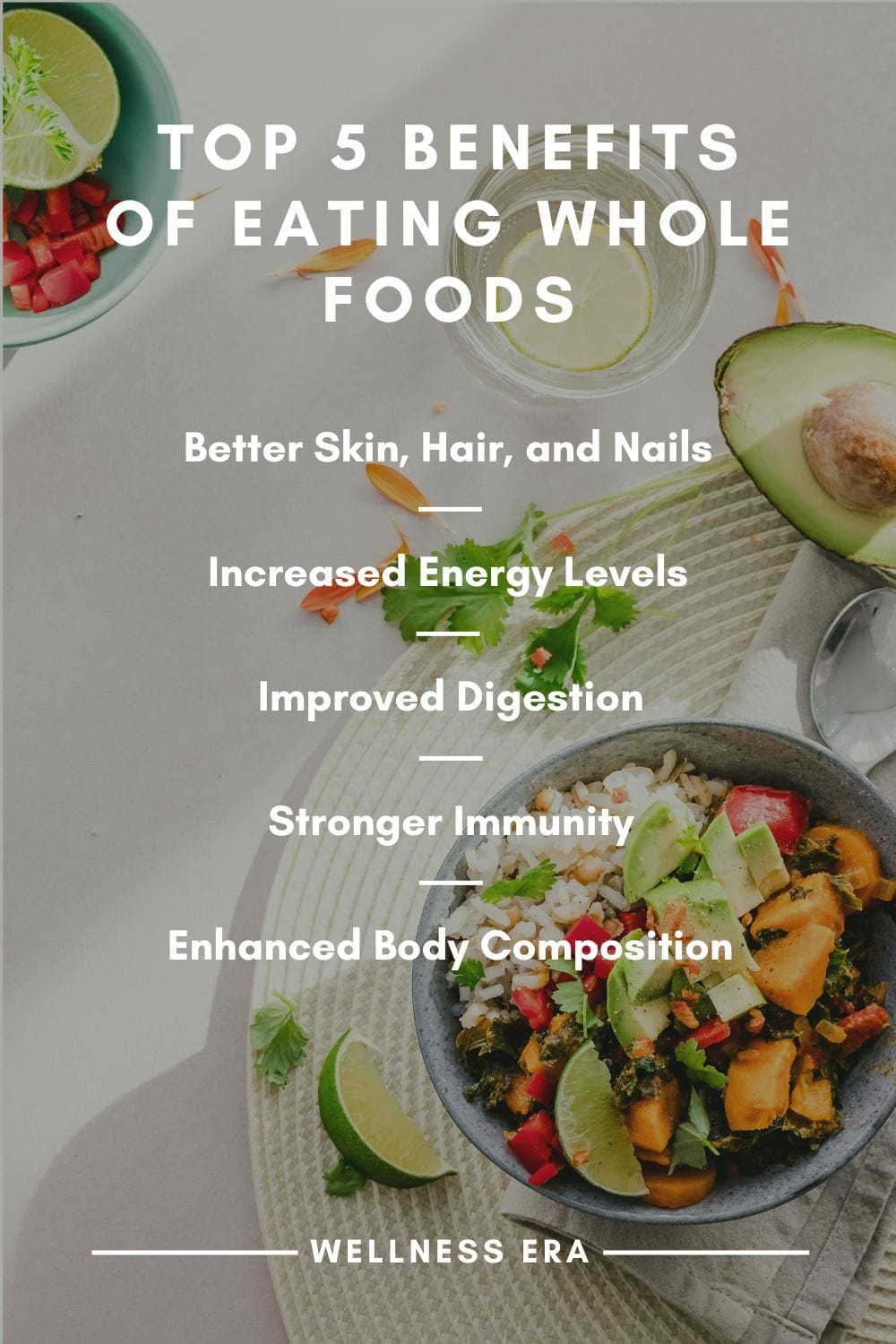
References
Pongcharoen, S., Wanachantararak, P. and Chaithirayanon, K., 2016. Biotin and vitamin C serum levels and hair loss. Journal of Cosmetic Dermatology, 15(3), pp.214-221.
Slavin, J.L., 2013. Fiber and prebiotics: mechanisms and health benefits. Nutrients, 5(4), pp.1417-1435.
Nimse, S.B. and Pal, D., 2015. Free radicals, natural antioxidants, and their reaction mechanisms. RSC Advances, 5(35), pp.27986-28006.
5. How Whole Foods Support Vital Organs: Gut, Heart, Brain, and Beyond
Eating whole foods isn’t just about fueling your body—it’s about supporting the organs that keep you healthy and thriving. From your gut to your heart, brain, kidneys, liver, and lungs, whole food nutrition has a profound effect on your overall well-being.
Gut Health: The Foundation of Wellness
The gut is often called the “second brain” for a reason—it plays a major role in your digestion, immune system, and even your mood. Whole foods rich in fiber (like fruits, vegetables, and whole grains) help nourish your gut microbiome, the community of bacteria that supports digestion and nutrient absorption (Slavin, 2013). A healthy gut not only keeps your digestive system running smoothly but also helps regulate inflammation, which is linked to various chronic diseases.
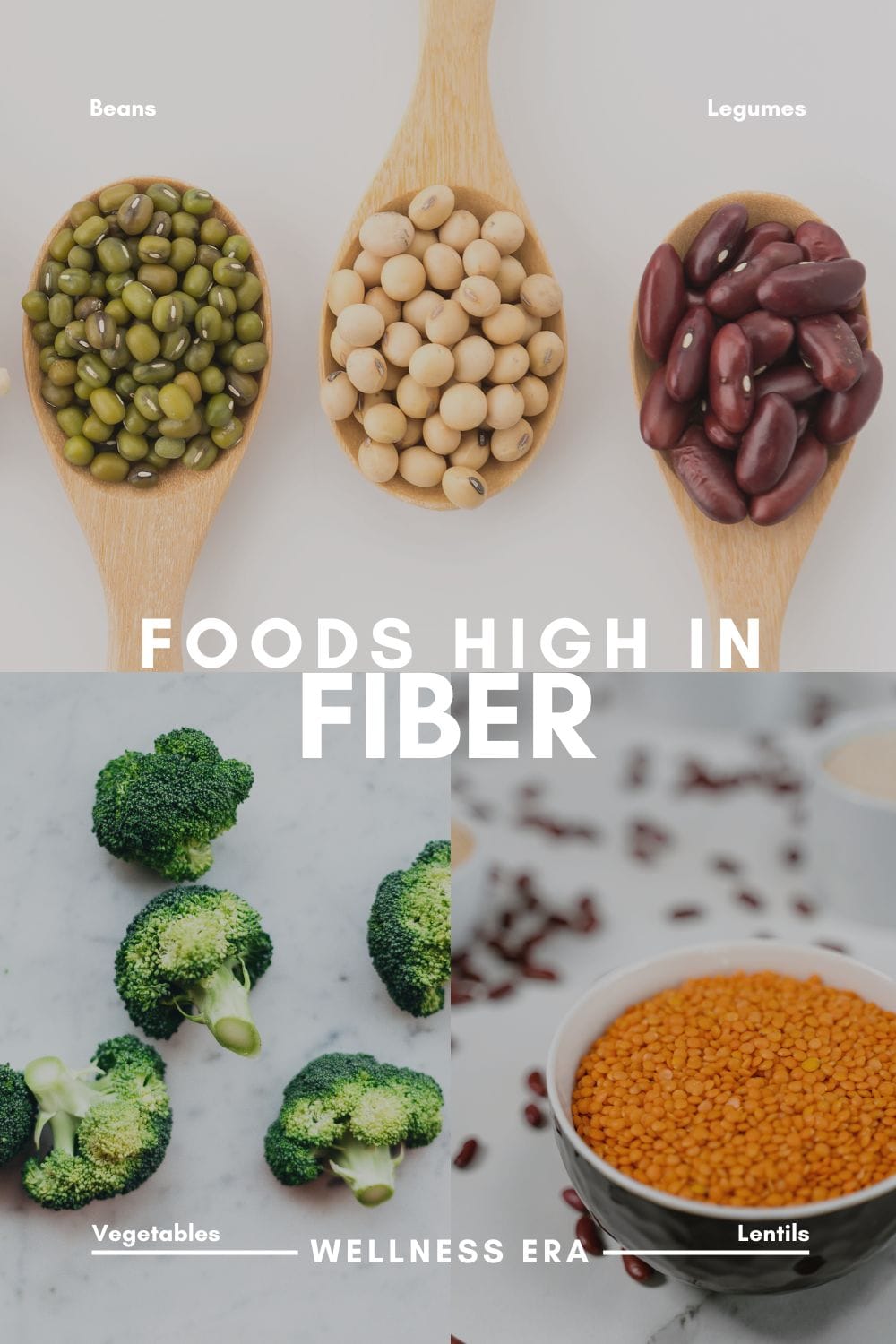
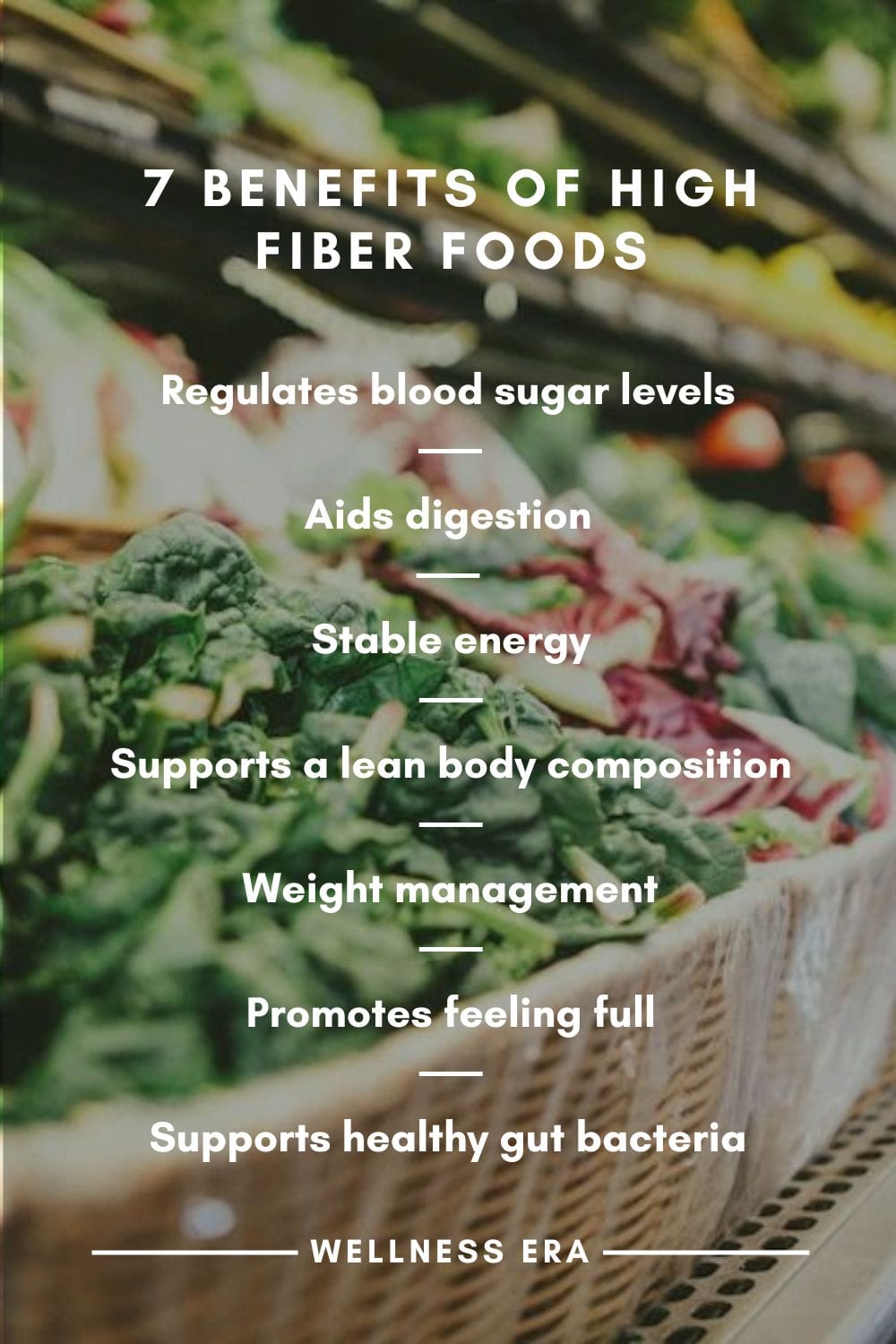
Heart Health: Protecting Your Cardiovascular System
Whole foods, especially those rich in healthy fats like avocados, nuts, and fatty fish, can help lower bad cholesterol levels and reduce the risk of heart disease. Studies show that diets rich in omega-3 fatty acids and antioxidants, commonly found in whole foods, help prevent cardiovascular issues by reducing inflammation and supporting healthy blood flow (Simopoulos, 2002). Whole grains like oats and quinoa, packed with fiber, also contribute to lower cholesterol and better heart health.
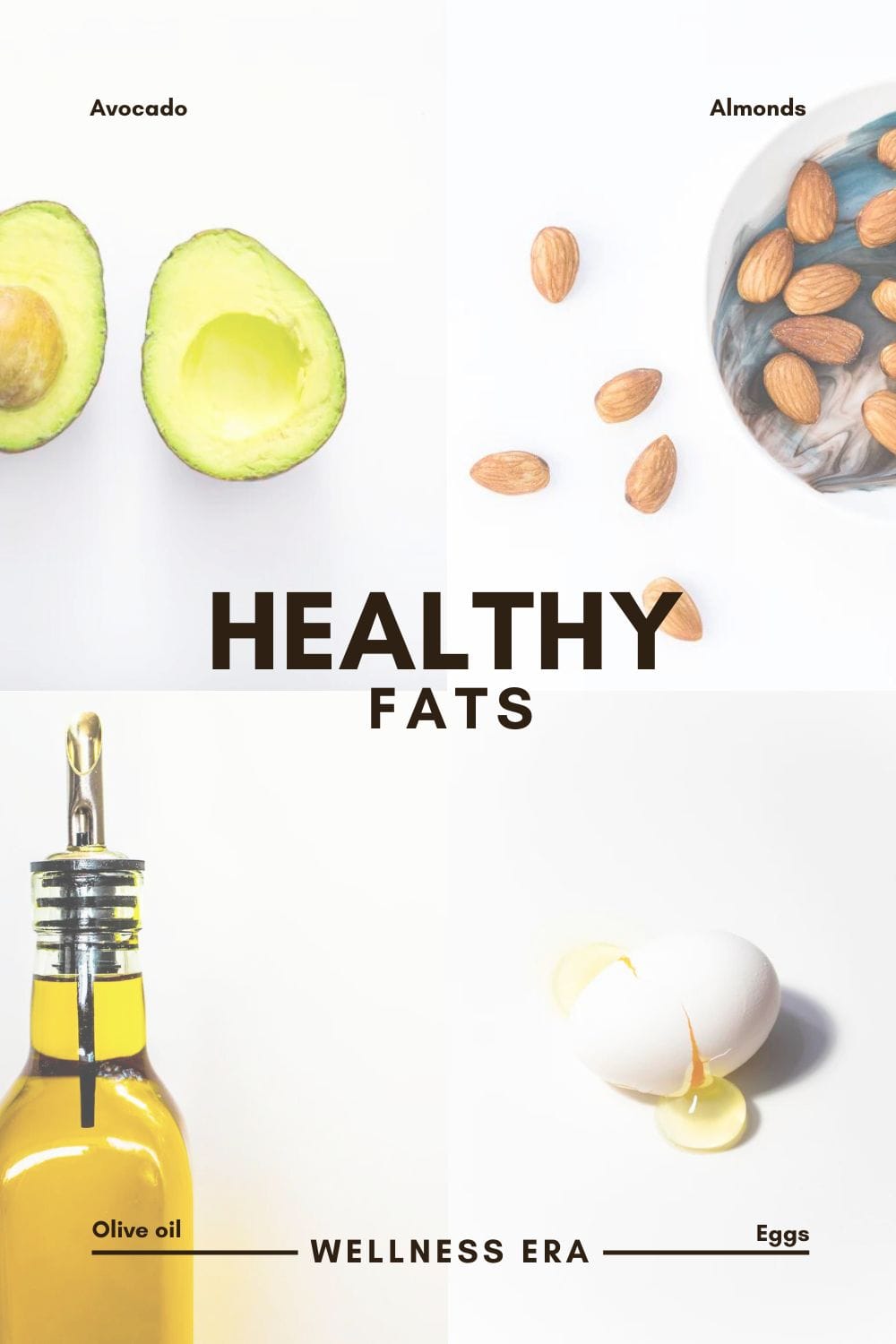
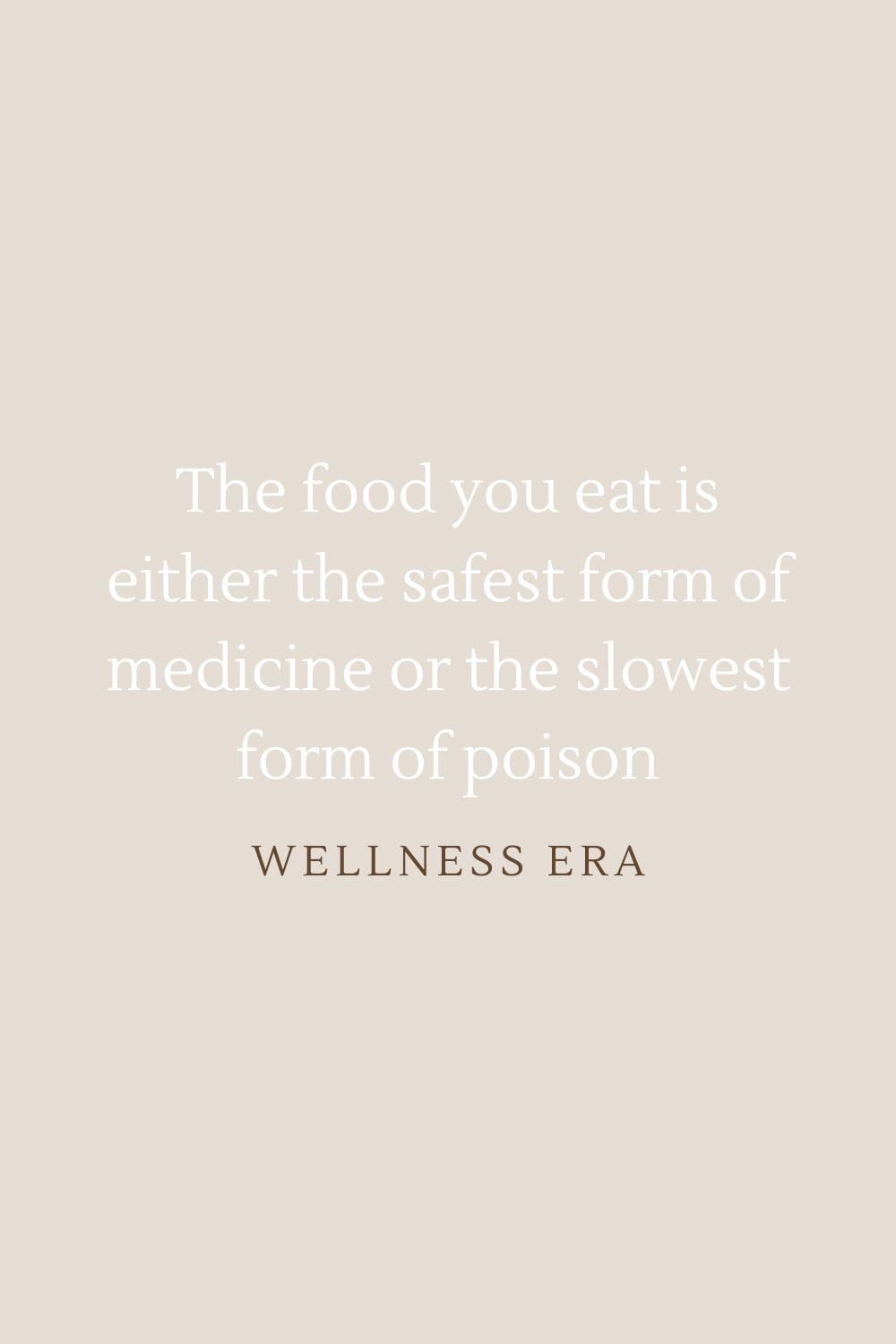
Brain Health: Fueling Cognitive Function
Your brain relies on nutrients like omega-3 fatty acids, found in fish like salmon, to function at its best. These healthy fats help protect brain cells and reduce cognitive decline as you age. Antioxidants from colorful fruits and vegetables, such as berries and leafy greens, combat oxidative stress and inflammation, which are linked to brain aging and neurodegenerative diseases (Joseph et al., 2009).
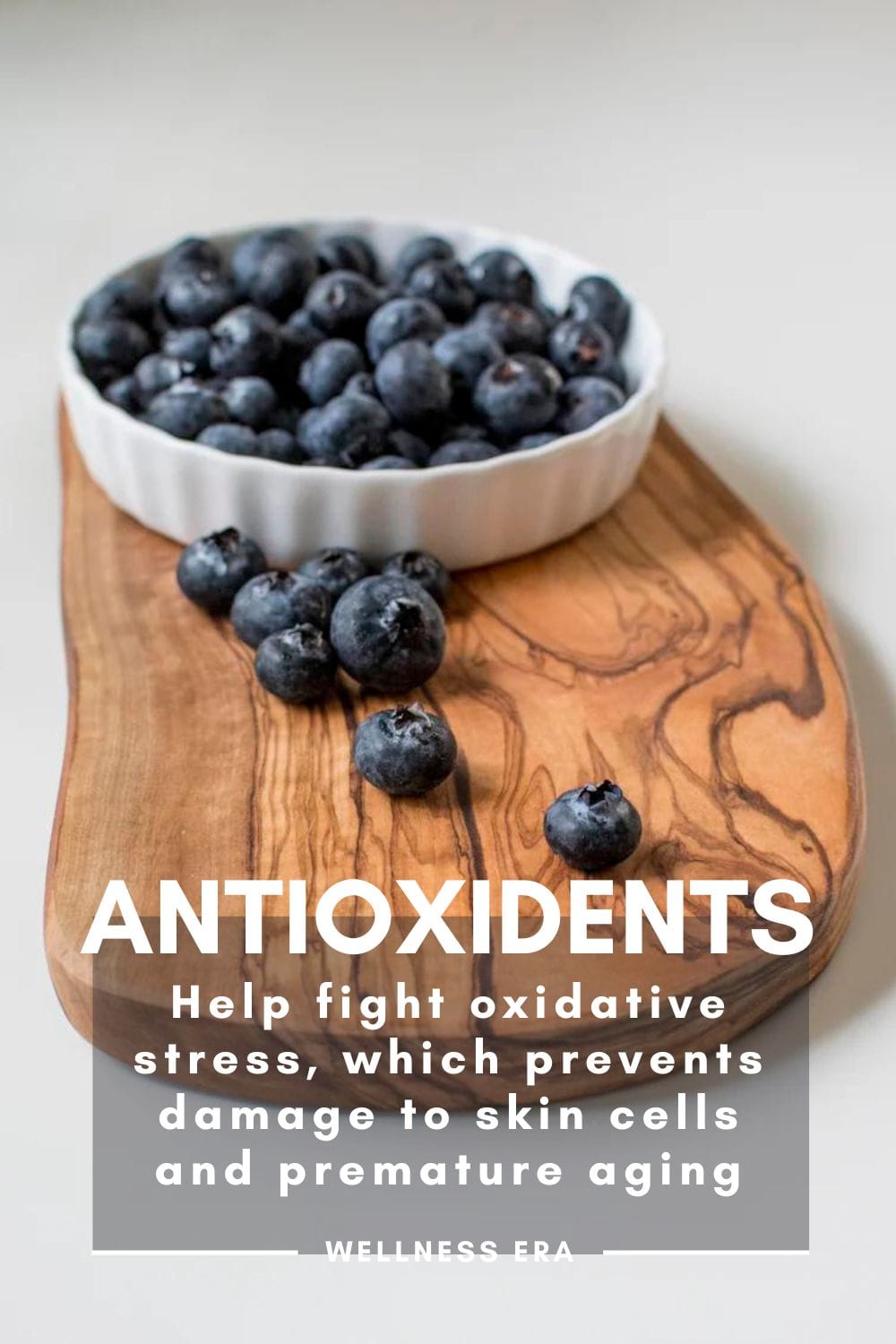
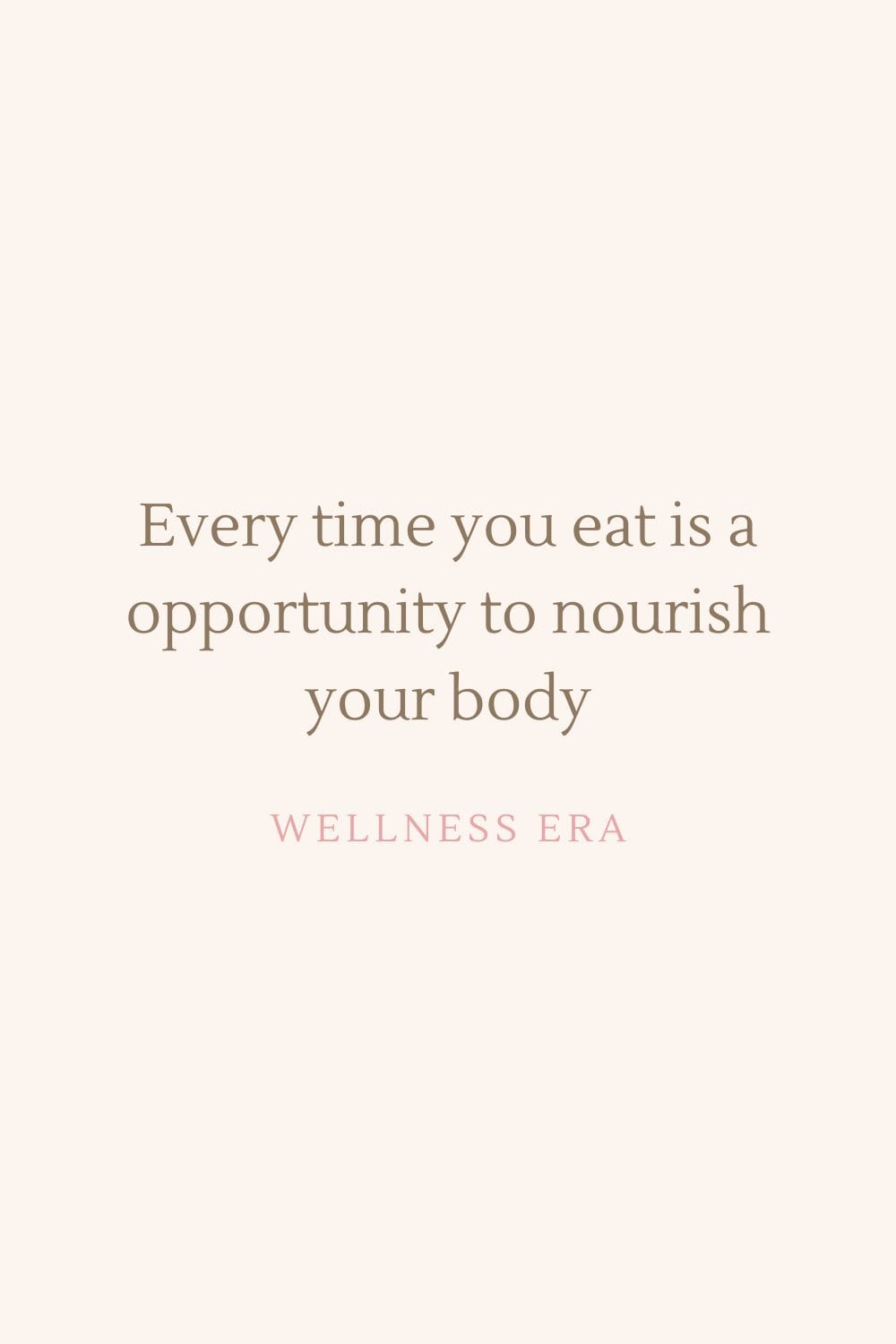
Kidney Health: Supporting Detox and Filtration
Whole foods, especially those low in sodium and rich in potassium, support kidney function by helping regulate your body’s fluid balance and filtration system. Foods like bananas, spinach, and sweet potatoes are naturally high in potassium, which helps maintain healthy blood pressure levels and reduces the strain on your kidneys (Whelton et al., 2012).
Liver Health: Detoxifying Your Body
Your liver is responsible for detoxifying the body and metabolizing fats, proteins, and carbohydrates. Whole foods like leafy greens, garlic, and cruciferous vegetables (e.g., broccoli and cauliflower) contain compounds that help your liver break down toxins more efficiently and support its natural detoxification processes (Lampe, 1999). A diet high in processed foods and refined sugars, on the other hand, can lead to fatty liver disease and inflammation.
Lung Health: Breathing Easy
Lung function is directly impacted by the quality of the food you eat. Whole foods rich in antioxidants, like vitamin Cfrom citrus fruits and beta-carotene from carrots, help protect the lungs from oxidative damage. Studies show that individuals who eat a diet high in fruits and vegetables are less likely to experience lung decline, especially as they age (Dietrich et al., 2006).
Eating a diet rich in whole foods nourishes not just your gut, but all the vital organs that keep you healthy and active. Whether it’s supporting brain function, protecting your heart, or detoxifying your liver, whole foods provide the nutrients your body needs to perform at its best.
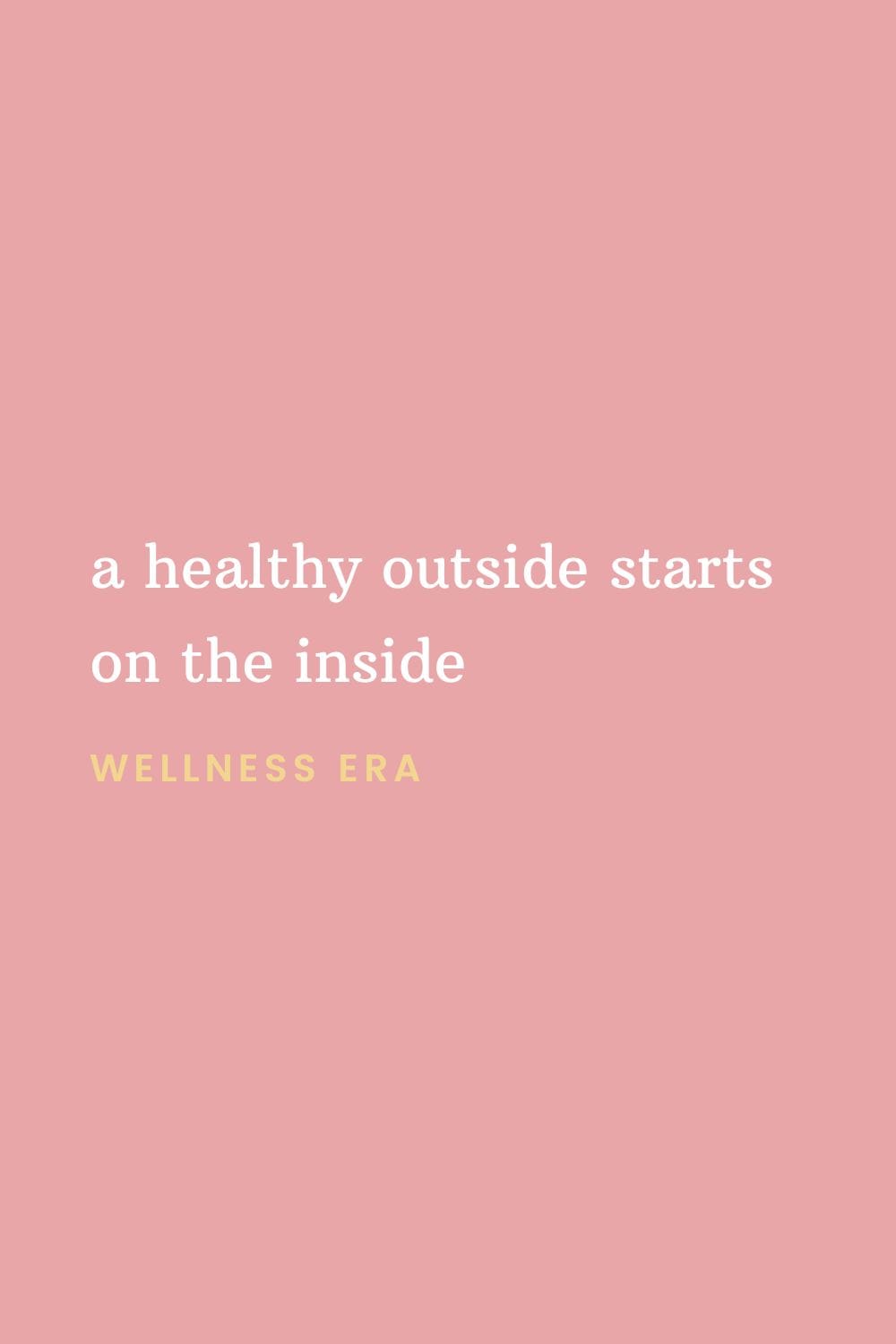
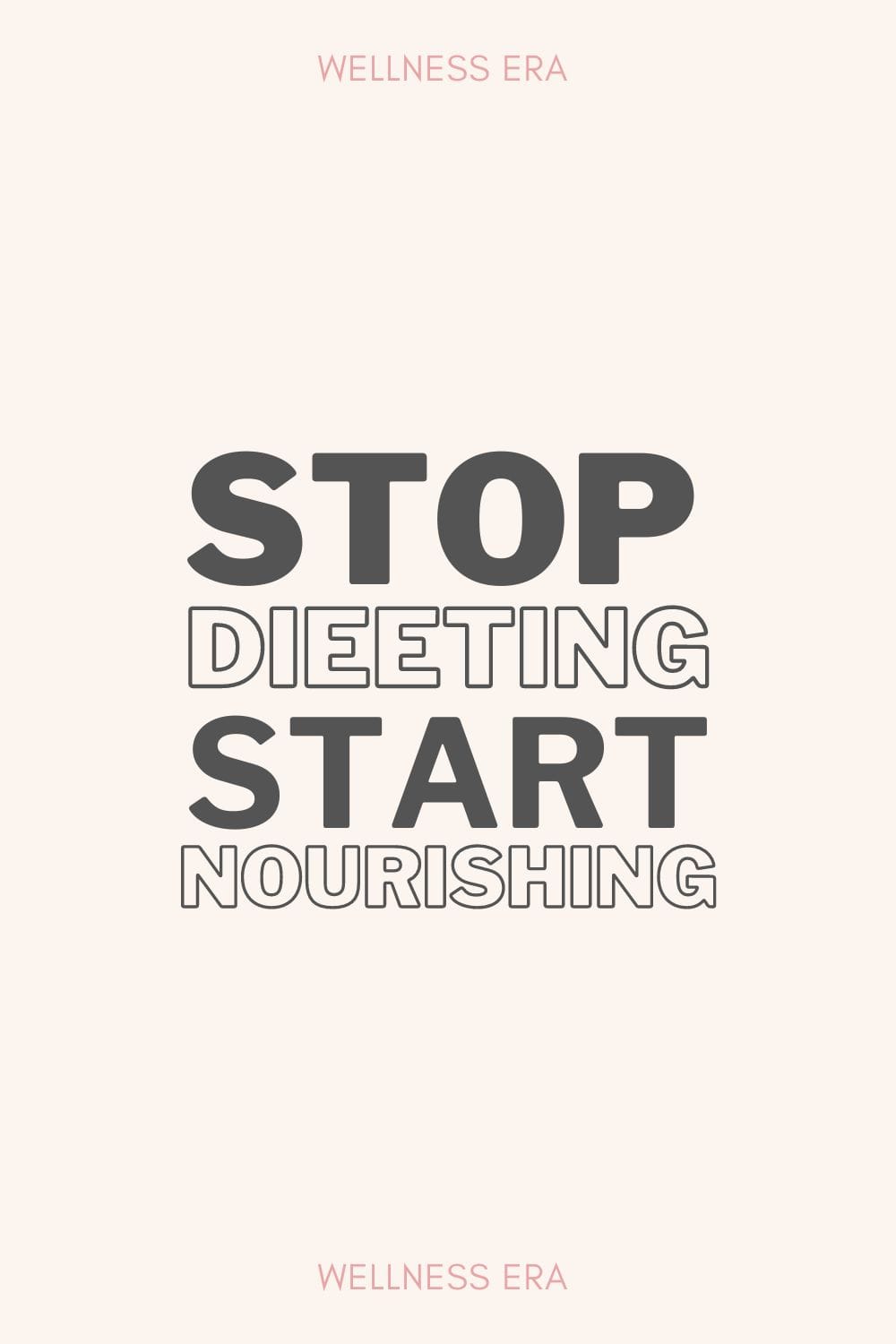
References
Simopoulos, A.P., 2002. Omega-3 fatty acids in inflammation and autoimmune diseases. Journal of the American College of Nutrition, 21(6), pp.495-505.
Joseph, J.A., Shukitt-Hale, B. and Casadesus, G., 2009. Reversing the deleterious effects of aging on neuronal communication and behavior: beneficial properties of fruit polyphenolic compounds. American Journal of Clinical Nutrition, 81(1), pp.313-316.
Whelton, P.K., He, J., Appel, L.J., Cutler, J.A., Havas, S., Kotchen, T.A. and Roccella, E.J., 2012. Primary prevention of hypertension: clinical and public health advisory from The National High Blood Pressure Education Program. JAMA, 288(15), pp.1882-1888.
Lampe, J.W., 1999. Health effects of vegetables and fruit: assessing mechanisms of action in human experimental studies. American Journal of Clinical Nutrition, 70(3), pp.475-490.
Dietrich, M., Block, G., Norkus, E.P., Hudes, M., Traber, M.G., Cross, C.E. and Packer, L., 2006. Smoking and exposure to environmental tobacco smoke decrease some plasma antioxidants and increase γ-tocopherol in vivo after adjustment for dietary antioxidant intakes. American Journal of Clinical Nutrition, 80(1), pp.160-166.
6. Common Myths About Whole Food Nutrition (and Why They’re Wrong)
Whole food nutrition can seem intimidating at first, especially with the number of misconceptions floating around. Let's bust a few of the most common myths to show you that eating whole foods can be accessible, affordable, and enjoyable.
Myth 1: Whole Foods Are Too Expensive
It’s true that certain organic or specialty items might have a higher price tag, but eating whole foods doesn’t have to break the bank. Staples like beans, lentils, oats, and in-season fruits and vegetables are not only affordable but also packed with nutrients. Buying in bulk or choosing frozen whole foods can help you save even more. Studies show that diets rich in whole foods can actually reduce healthcare costs by lowering the risk of chronic diseases like obesity, diabetes, and cardiovascular issues (Rehm et al., 2016).
The Truth: You don’t need to buy everything organic to eat well. Prioritize whole, unprocessed foods and be strategic with your shopping to keep costs low. There are many gradients in what is the best option for several products. Buy the best of what you can with your budget.
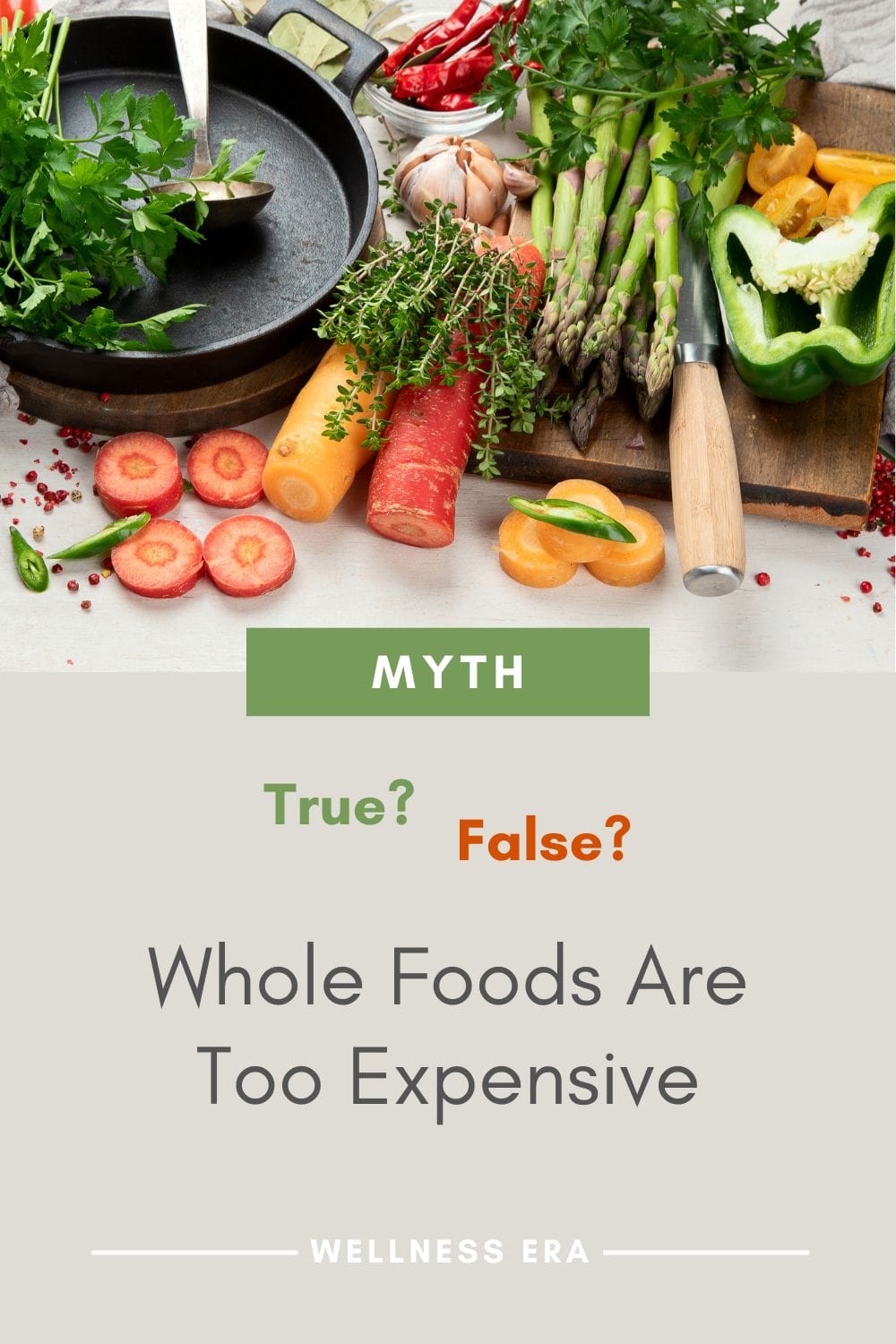
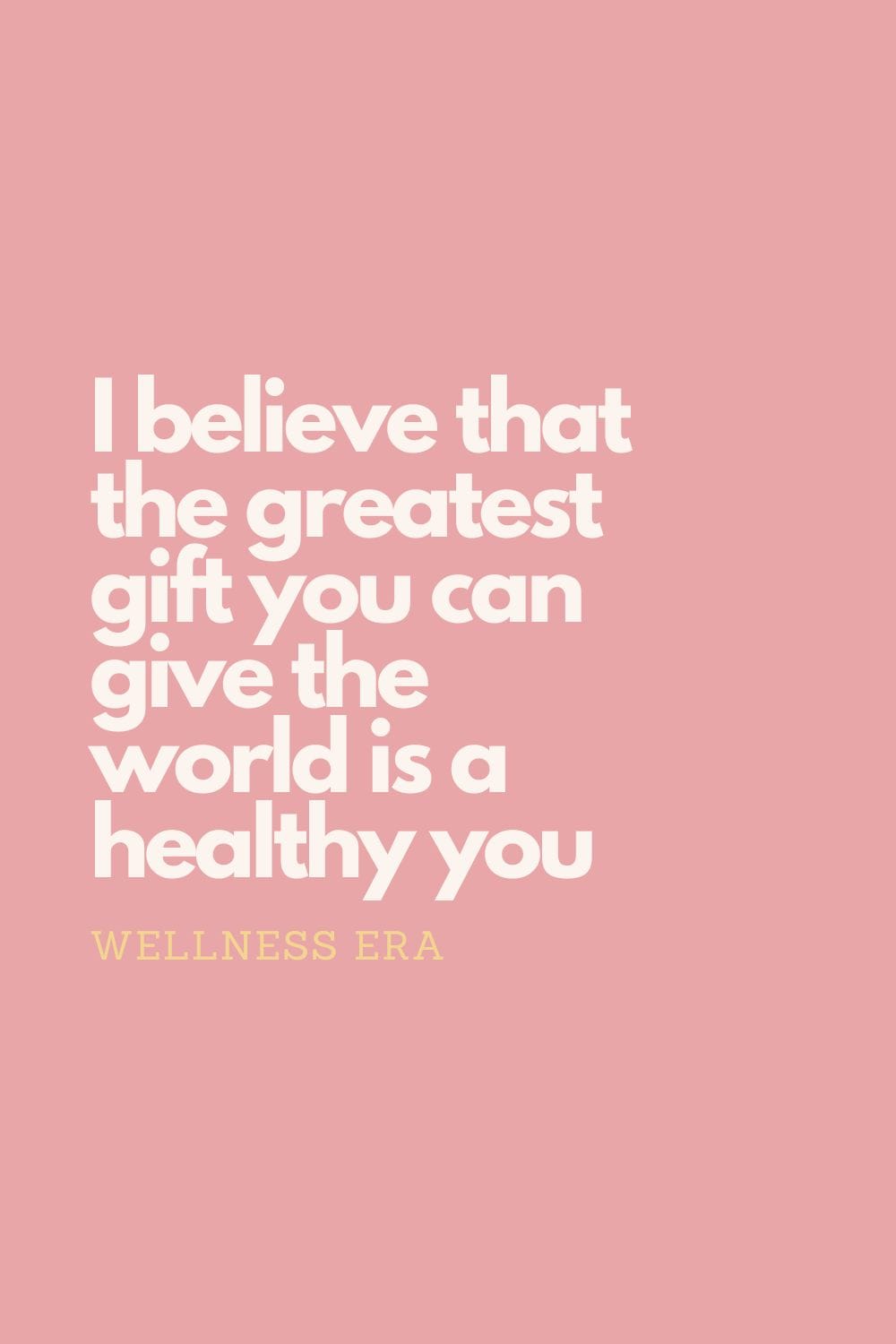
Myth 2: It’s Too Hard to Find Whole Foods
Many people think that whole foods are hard to come by or require trips to specialty stores. The truth? Whole foods are everywhere. You can find them at your local grocery store or farmers’ market. Fresh fruits, vegetables, grains, legumes, and proteins like eggs and fish are widely available.
The Truth: If it’s grown in the ground or sourced naturally, it’s a whole food. You can find whole food options at nearly any grocery store. Start by choosing fresh produce, whole grains, and minimally processed proteins.
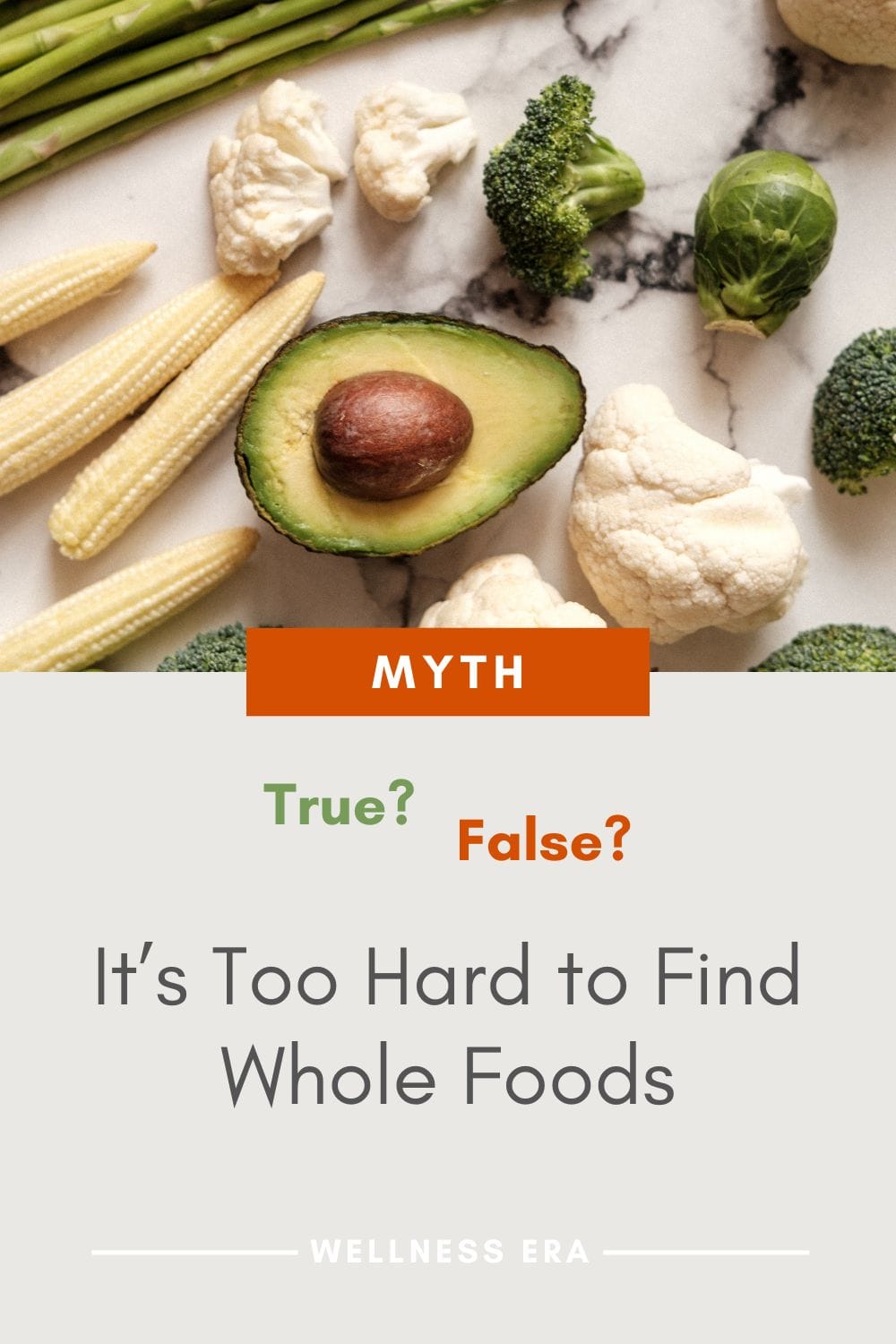

Myth 3: Whole Foods Are Bland and Boring
If you think whole foods are dull and lack flavor, think again. The key to making whole foods delicious is using natural herbs, spices, and healthy fats. Think about the savory richness of olive oil, the bold kick of garlic, or the refreshing zest of lemon. The beauty of whole foods is that they can be incredibly flavorful with just a few simple ingredients.
The Truth: Whole foods can be bursting with flavor if prepared with fresh herbs and spices. Once you start experimenting, you'll find that they offer far more versatility than processed meals.
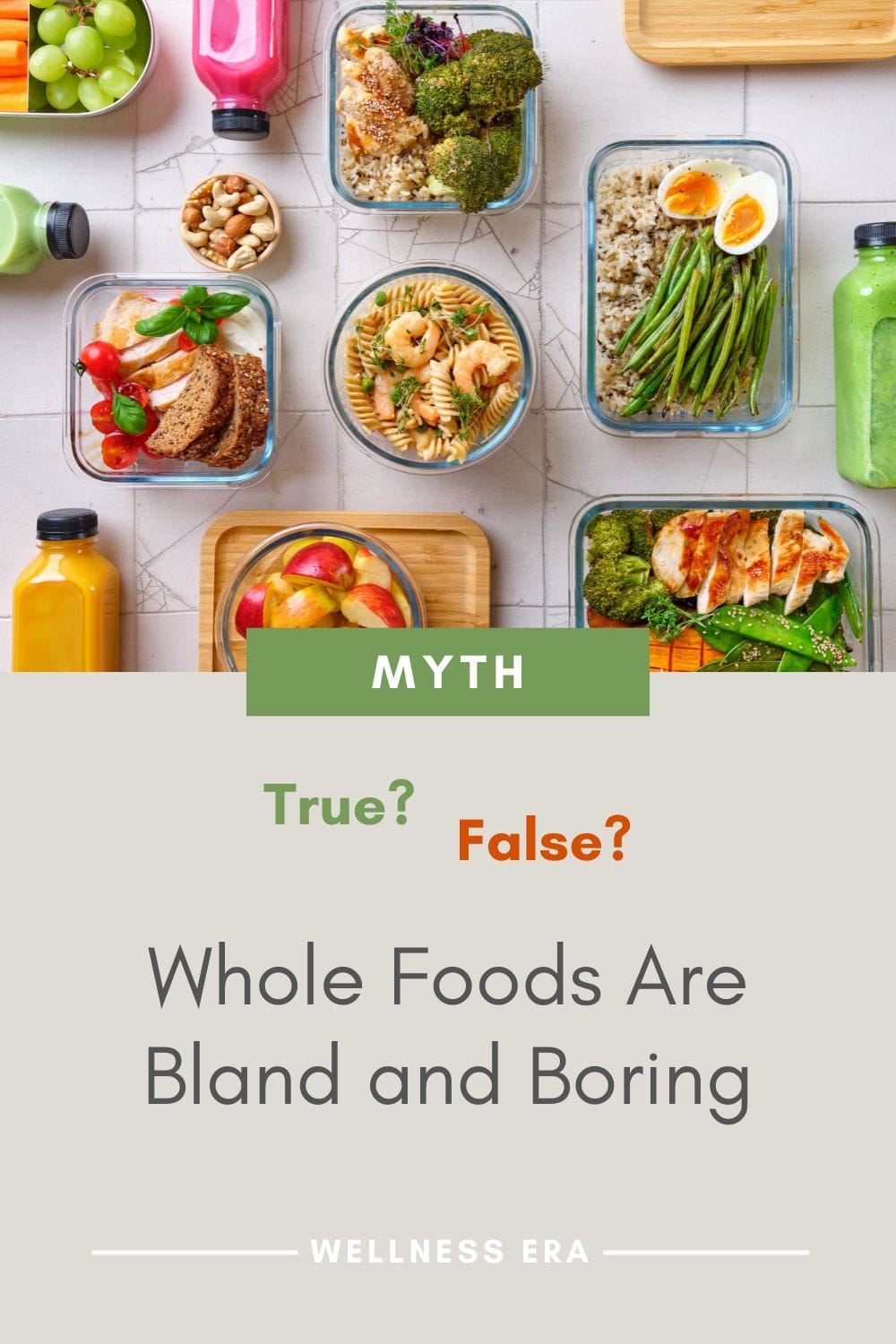
Myth 4: You Can’t Eat Whole Foods When You’re Busy
It’s easy to assume that eating whole foods takes too much time, but the reality is that whole food meals can be just as quick as grabbing processed snacks. With a bit of planning—such as meal prepping or making simple recipes that require minimal ingredients—you can enjoy healthy, nourishing meals even on your busiest days.
The Truth: Simple whole food meals don’t require a lot of time or effort. With meal planning and prepping, you can always have something healthy ready to go. It takes time to create à habit, but once you get it, it can definitely be quick and easy.

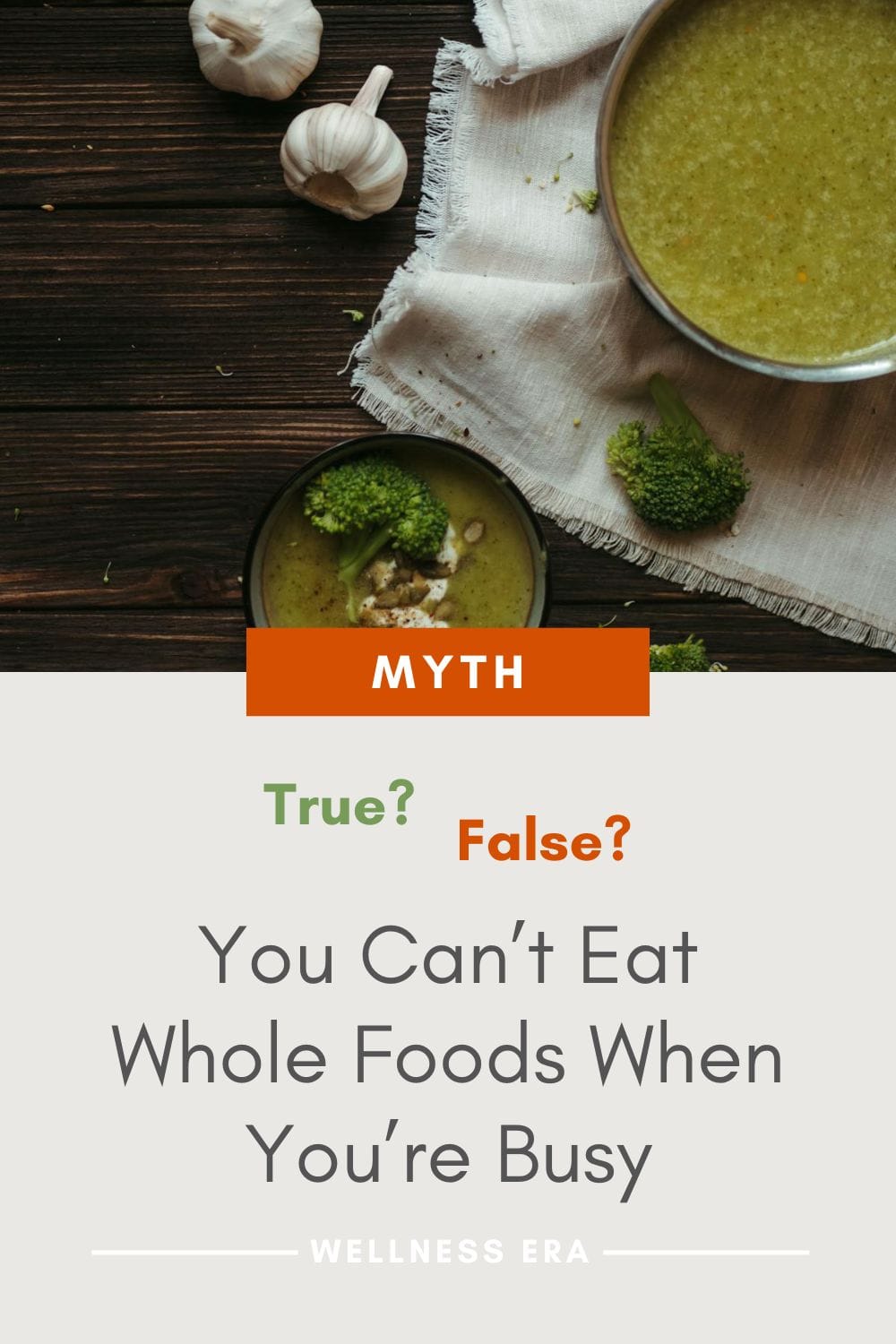
7. How to Transition to a Whole Food Diet
Transitioning to a whole food diet doesn’t have to be overwhelming. It’s all about making small, manageable changes that will gradually transform your eating habits. Here’s how you can start incorporating more whole foods into your daily routine:
1. Start by Reading Labels
Many products are labeled with buzzwords like "natural," "organic," “sugar-free” or "whole grain," but these terms can be misleading. Always check the ingredient list to make sure you're actually getting whole foods without added sugars, artificial flavors, or preservatives. For example, labels like "Made with whole grains" often include only a small percentage of whole grains, with the rest being refined flour. Another common label is "all-natural," which can still include processed ingredients.
Quick Tip: A simple rule of thumb is to think of foods with a barcode or that come in a box as likely processed. Reading labels and doing some research helps you understand exactly what you're consuming.
2. Make Simple Swaps
Start small by swapping out processed items with their whole food counterparts. For instance, replace white bread with whole grain bread, such as sourdough or sugary snacks with fresh fruit. Over time, these small changes will add up and transform your diet.
Quick Tip for Vegans: Although plant-based milk seems to be à nutritious substitute, they pretty much always contain additives such as seed oils and preservatives. À simple way of including whole food plant-based milk in your diet, is to get yourself à milk maker, some non-processed nuts or oats and water. It will even save you money too.
3. Embrace Simple, Whole Food Recipes
Don’t feel like you need to make gourmet meals every day. Some of the best whole food meals are incredibly simple and only require a few ingredients. À protein filled soup of lentils, bone broth and broccoli, or a grain bowl with quinoa, roasted veggies, salmon and a drizzle of extra virgin olive oil, can be both quick and delicious.
Quick Tip: Search for easy whole food recipes online or on social media. Start with a few simple dishes and slowly build your cooking confidence.
4. Invest in Spices and Herbs
One of the easiest ways to make whole foods flavorful is by using fresh herbs and spices. Instead of relying on processed sauces or pre-made meal kits, invest in quality spices like turmeric, cumin, or oregano, which not only enhance flavor but also offer added health benefits. Organic herbs and spices can last for a long time and can be used in a variety of dishes.
Quick Tip: Try seasoning your meals with herbs like basil and parsley or spices like cinnamon and paprika to add flavor and nutrients without extra calories or chemicals.
5. Plan Ahead and Meal Prep
Life can get busy, and when you're pressed for time, it's tempting to grab the first thing you see—which is often processed snacks. To avoid this, make meal prepping part of your routine. Set aside time each week to plan your meals, chop veggies, or cook grains and proteins that can be easily mixed into dishes later. This way, you’ll always have healthy, whole foods ready when hunger strikes.
Quick Tip: Start small by prepping a couple of ingredients for the week, like roasted veggies or cooked grains. Having these on hand will make it easier to create meals on the go.
6. Don’t Stress About Perfection
You don’t have to overhaul your entire diet overnight. Focus on progress, not perfection. If you’re making more whole food choices today than yesterday, you’re on the right track. Take it one step at a time, and allow yourself the flexibility to enjoy the process.
Quick Tip: Remember that whole food nutrition is a journey. Give yourself grace and celebrate the small wins, like adding an extra serving of vegetables to your plate.
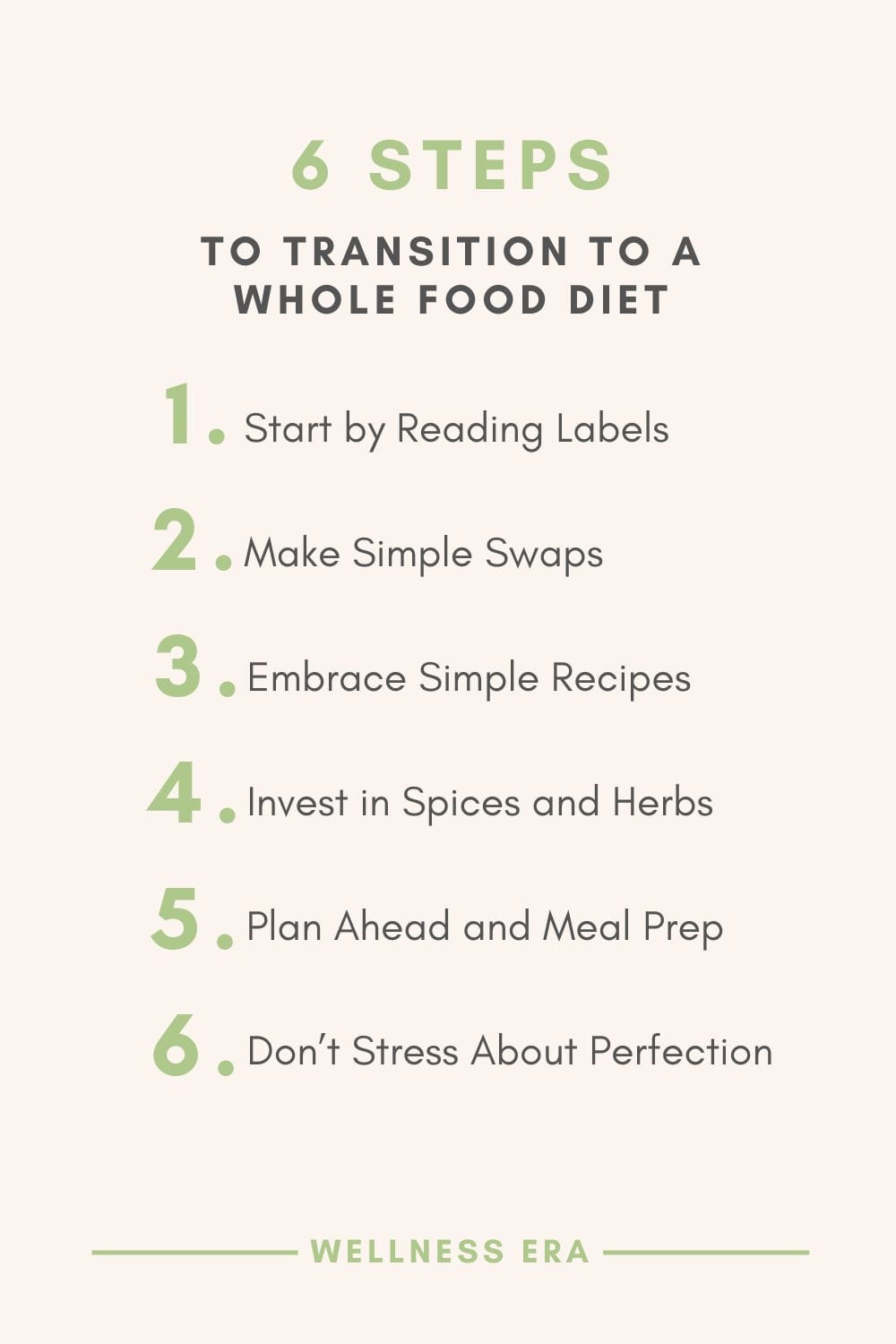
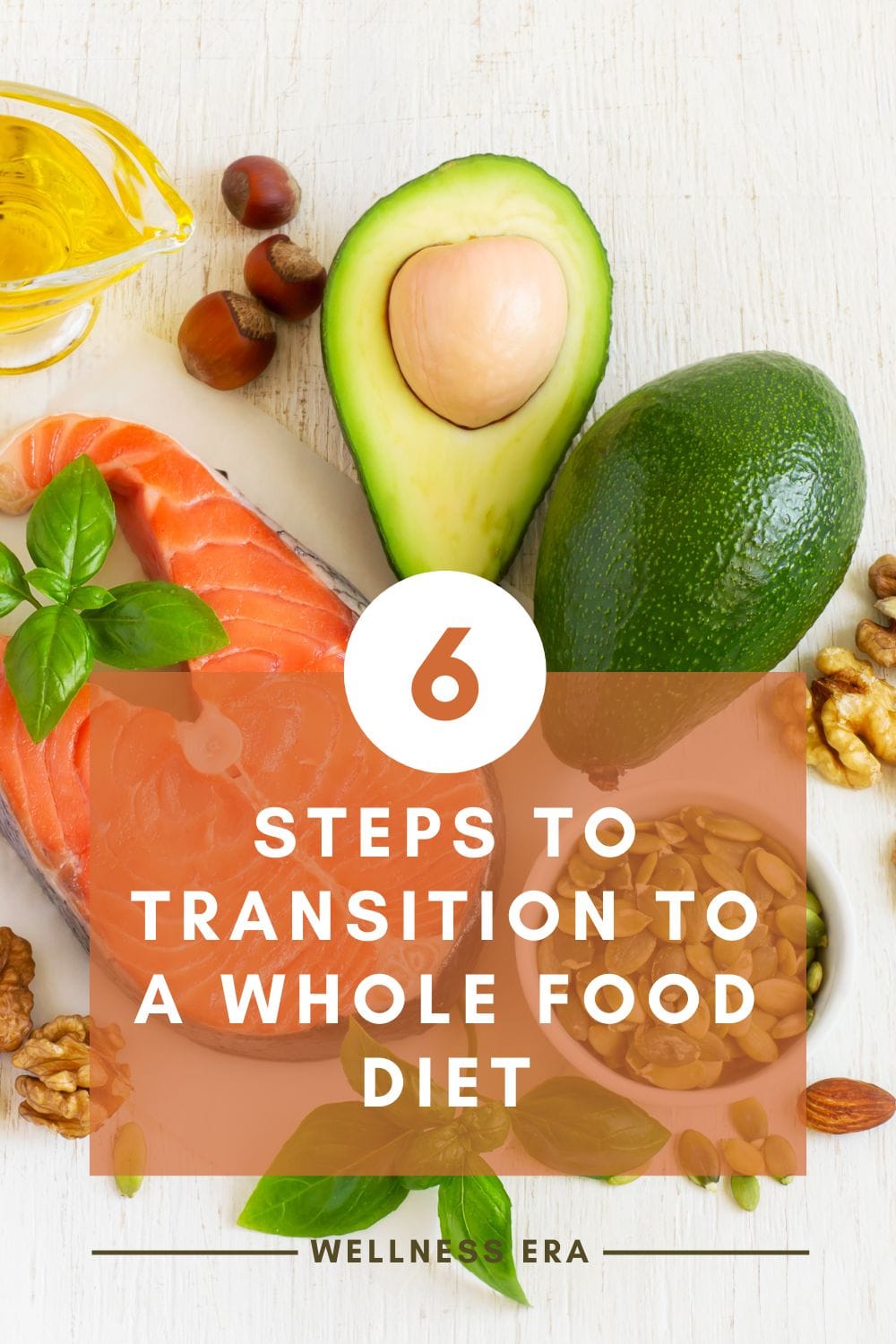
Transitioning to a whole food diet is all about taking small, meaningful steps. With a little planning, label reading, and a few easy swaps, you can create lasting habits that support your overall health and wellness. Before you know it, you’ll be fueling your body with the foods that nourish you best.
References
Rehm, C.D., Monsivais, P., and Drewnowski, A., 2016. The quality and cost of diets consumed by adults in the United States. JAMA Internal Medicine, 176(1), pp.41-48.
Slavin, J.L., 2013. Fiber and prebiotics: mechanisms and health benefits. Nutrients, 5(4), pp.1417-1435.
8. The Long-Term Benefits of Eating Whole Foods
Adopting a whole food diet isn’t just about making short-term changes—it’s about transforming your health for the long haul. Here’s how eating whole foods can benefit you in the long run:
Improved Longevity
Whole foods are packed with antioxidants, vitamins, and minerals that help protect your cells from damage and inflammation. Antioxidants found in fruits, vegetables, and whole grains fight free radicals, which contribute to aging and chronic diseases like heart disease, cancer, and Alzheimer's (Nimse & Pal, 2015). Studies show that individuals who follow whole food-rich diets, such as the Mediterranean diet, tend to live longer and have a lower risk of chronic diseases (Martínez-González et al., 2014).
Long-Lasting Energy and Better Mood
Processed foods, especially those high in sugar, can cause blood sugar spikes followed by crashes, leading to fatigue and mood swings. Whole foods, on the other hand, provide sustained energy. Complex carbohydrates from whole grains, legumes, and starchy vegetables are digested slowly, maintaining stable blood sugar levels and providing consistent energy throughout the day (Slavin, 2013). This steady energy not only keeps you productive but also supports better mental clarity and a more balanced mood.
Healthier Skin, Hair, and Nails
Whole foods support radiant skin, strong nails, and shiny hair by supplying your body with the essential vitamins and minerals it needs. Foods rich in vitamin C (like citrus fruits) promote collagen production, essential for skin elasticity and preventing premature aging. Healthy fats from sources like avocado and fatty fish are crucial for keeping your skin hydrated and reducing inflammation, which can cause acne and redness (Simopoulos, 2002). Over time, a diet rich in these nutrients will leave your skin glowing and your hair and nails stronger.
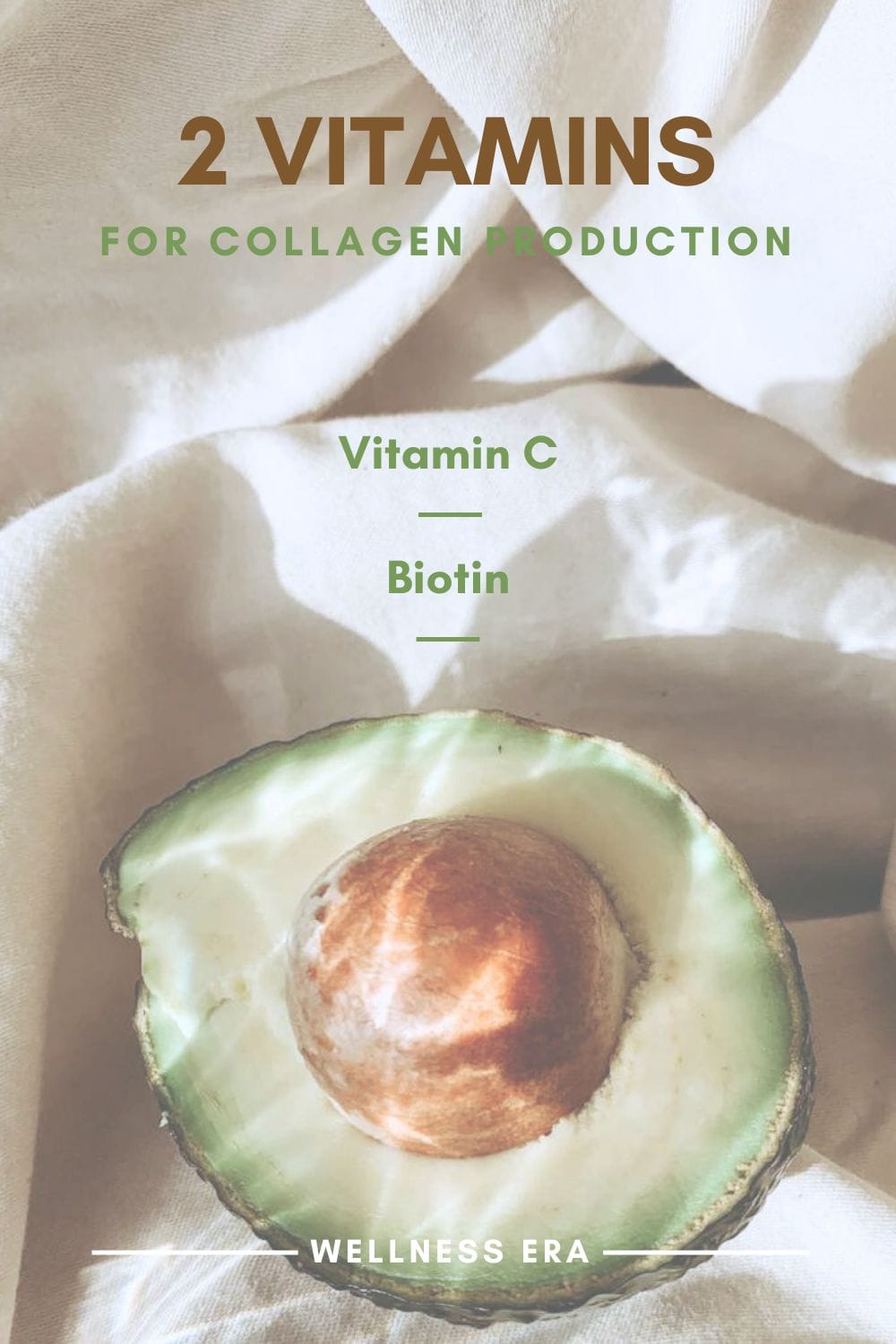
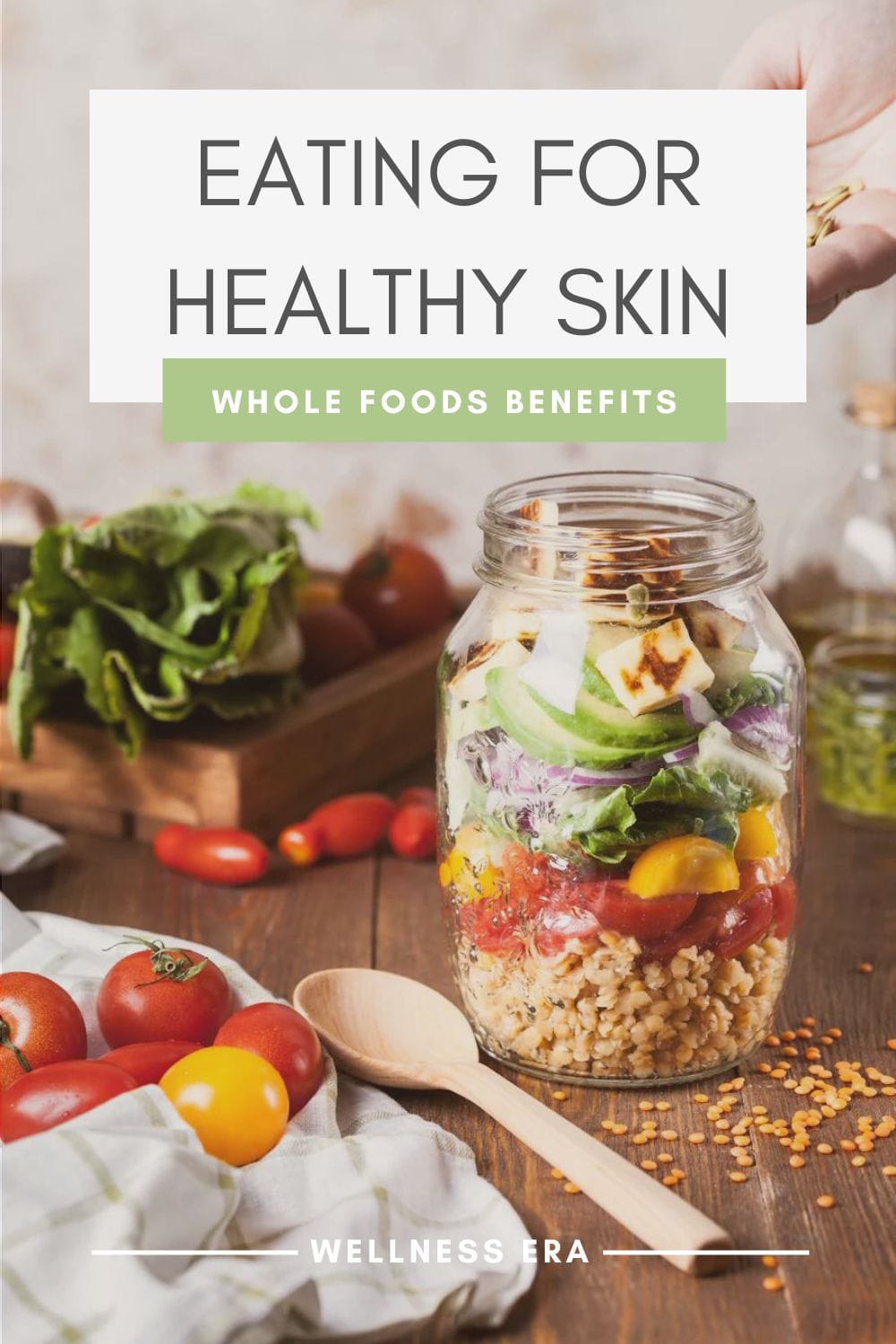
Reduced Risk of Chronic Diseases
A whole food diet helps protect against a range of chronic diseases. Diets high in processed foods—laden with refined sugars, unhealthy fats, and artificial additives—are linked to obesity, heart disease, type 2 diabetes, and certain cancers (Monteiro et al., 2018). Whole foods, particularly those high in fiber, antioxidants, and healthy fats, can significantly reduce the risk of these conditions. For example, research shows that fiber from whole grains, fruits, and vegetables helps reduce the risk of cardiovascular disease by lowering cholesterol levels and regulating blood sugar (Slavin, 2013).
Enhanced Body Composition and Weight Management
Whole foods, especially those rich in fiber, help maintain a healthy weight by promoting a feeling of fullness and reducing the likelihood of overeating. Unlike processed foods, which often lead to weight gain due to empty calories and low satiety, whole foods keep you satisfied longer. Additionally, whole food diets encourage healthy metabolism and support muscle maintenance when paired with physical activity (Slavin, 2013).
Better Gut Health
Fiber is one of the most important nutrients for long-term gut health, and whole foods are rich in it. High-fiber foods, such as legumes, vegetables, fruits, and whole grains, promote the growth of beneficial gut bacteria, which in turn aids digestion, boosts immunity, and supports overall health (Makki et al., 2018). A healthy gut microbiome has even been linked to better mental health, as the gut and brain communicate through the gut-brain axis.
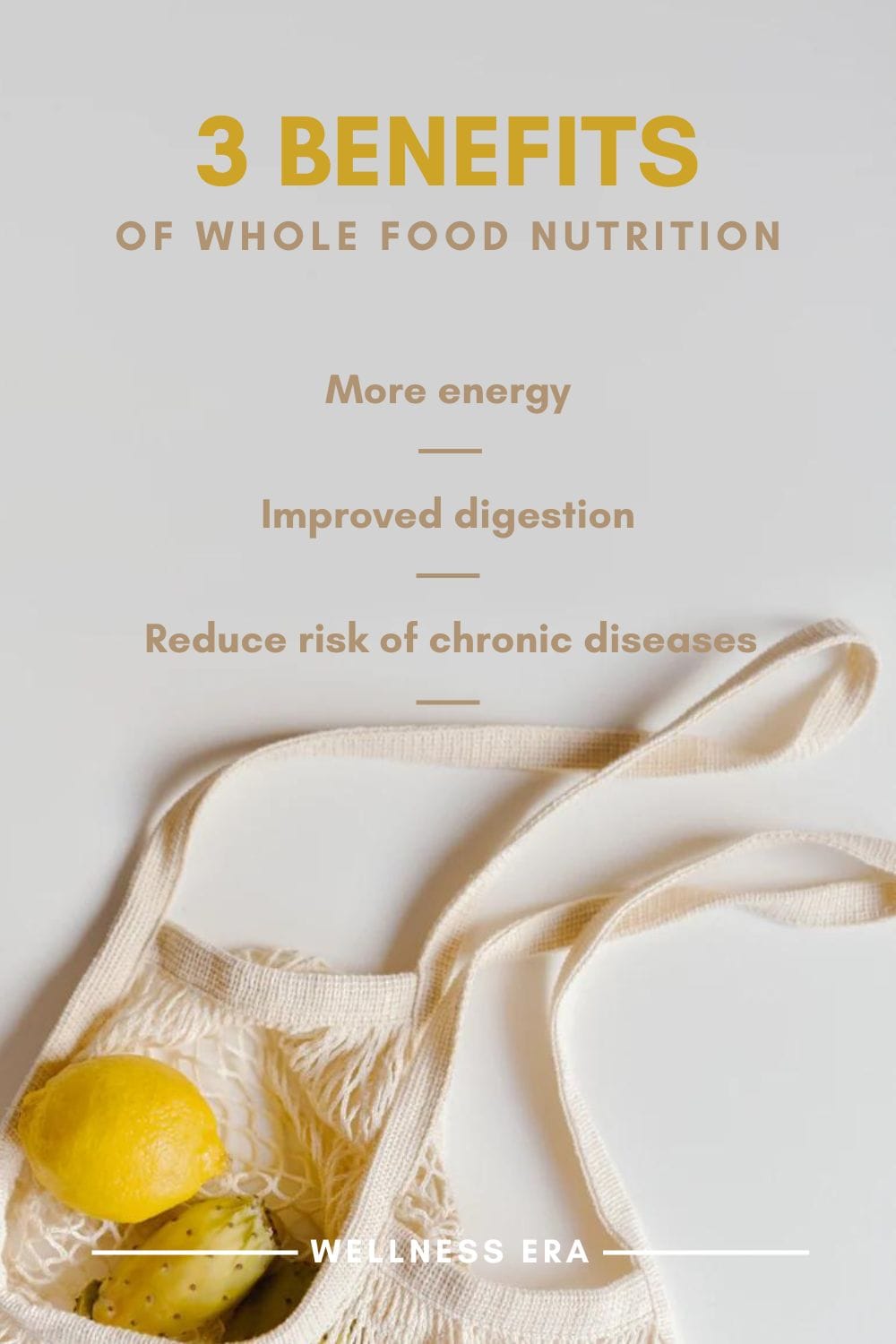
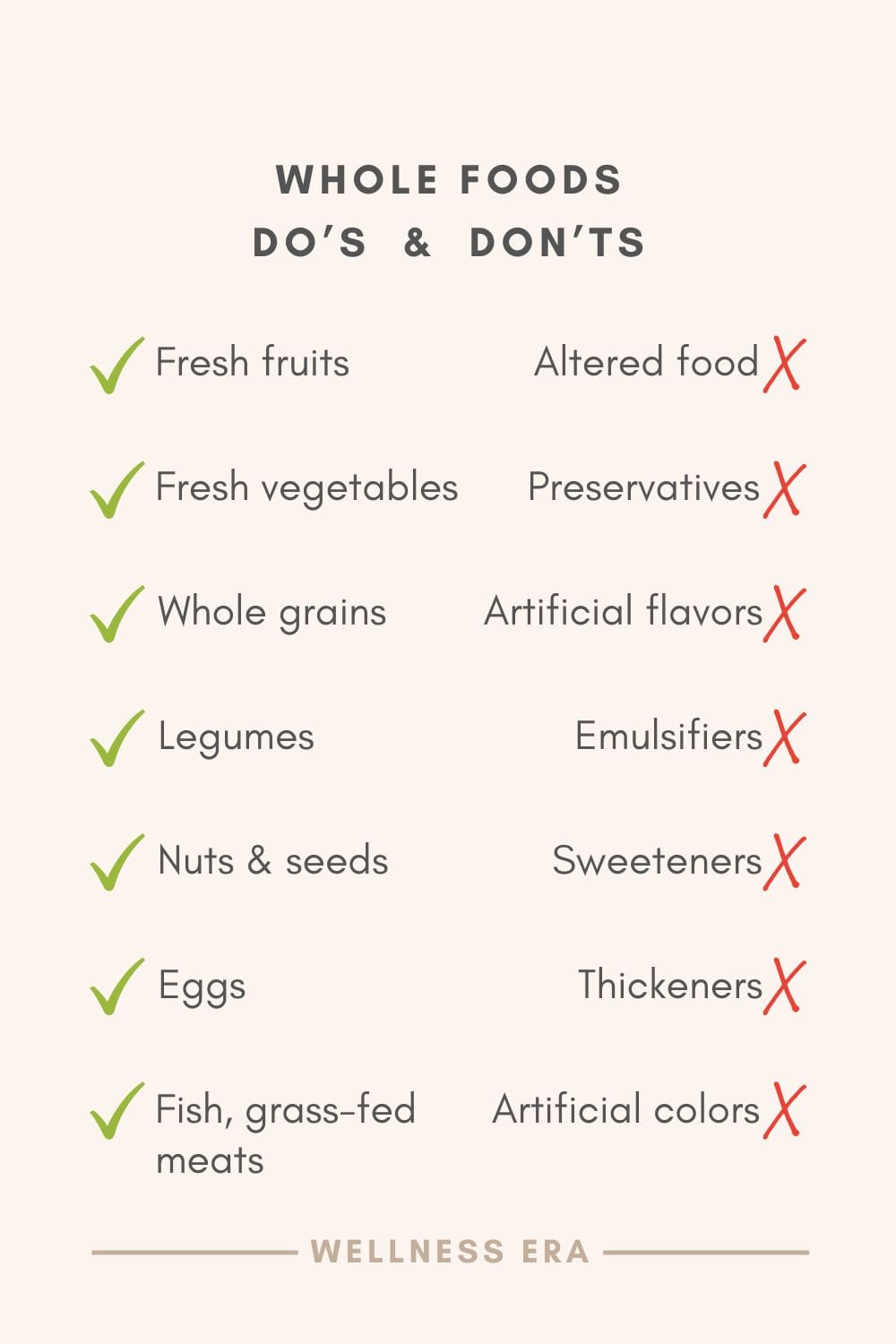
The Bottom Line: The long-term benefits of whole foods are undeniable. From glowing skin and increased energy to reduced risk of disease and better mental clarity, eating whole foods is an investment in your future health and well-being.
References
Nimse, S.B. and Pal, D., 2015. Free radicals, natural antioxidants, and their reaction mechanisms. RSC Advances, 5(35), pp.27986-28006.
Martínez-González, M.A., Hershey, M.S., Zazpe, I. and Trichopoulou, A., 2014. Transferability of the Mediterranean diet to non-Mediterranean countries. What Is Mediterranean Diet?, pp.151-160.
Simopoulos, A.P., 2002. Omega-3 fatty acids in inflammation and autoimmune diseases. Journal of the American College of Nutrition, 21(6), pp.495-505.
Slavin, J.L., 2013. Fiber and prebiotics: mechanisms and health benefits. Nutrients, 5(4), pp.1417-1435.
Monteiro, C.A., Cannon, G., Moubarac, J.C., Levy, R.B., Louzada, M.L. and Jaime, P.C., 2018. Ultra-processed foods: what they are and how to identify them. Public Health Nutrition, 22(5), pp.936-941.
Makki, K., Deehan, E.C., Walter, J. and Bäckhed, F., 2018. The impact of dietary fiber on gut microbiota in host health and disease. Cell Host & Microbe, 23(6), pp.705-715.
9. Frequently Asked Questions About Whole Food Nutrition
1. What Exactly Are Whole Foods?
Whole foods are foods that are minimally processed or unprocessed, meaning they retain their natural form and nutrients. This includes fresh fruits and vegetables, whole grains, legumes, nuts, seeds, and lean proteins. Unlike processed foods, which often contain additives, preservatives, and refined sugars, whole foods provide your body with essential vitamins, minerals, fiber, and healthy fats.

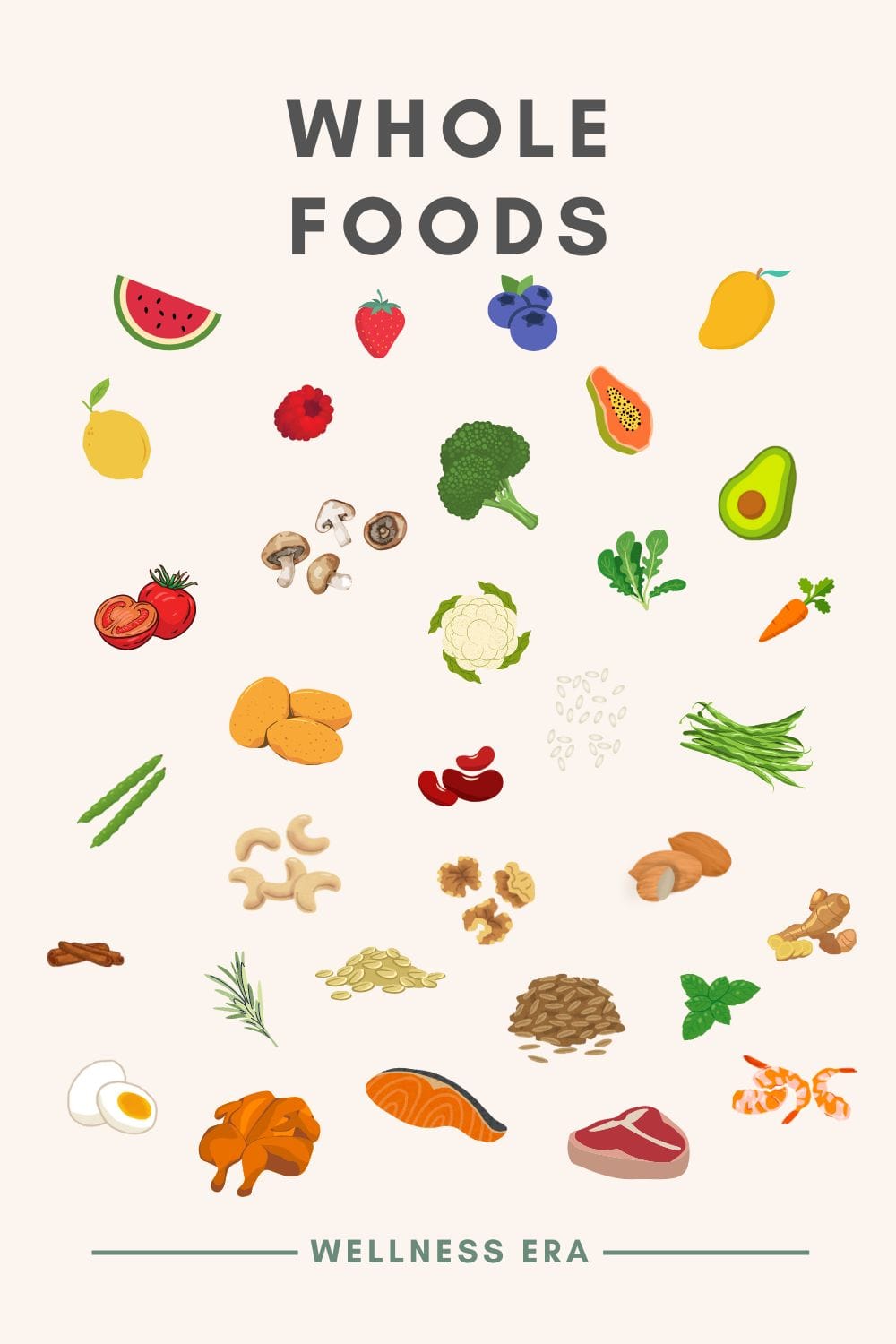
2. Can I Eat Frozen or Canned Foods? Are They Considered Whole Foods?
Yes! Frozen fruits and vegetables are great options when fresh produce isn’t available or convenient. In fact, frozen produce is often flash-frozen at its peak ripeness, which locks in nutrients. Canned foods can also be considered whole foods if they contain minimal additives—just check the labels. Look for canned beans, vegetables, or fruits that are low in added sodium or sugar.
3. How Do I Know If a Product Labeled “Natural” or “Whole” Is Really Whole Food?
Be cautious with labels like "natural" or "whole" as these terms can be misleading. Products may contain small amounts of whole food ingredients but still be highly processed. Always read the ingredient list. If the product contains a long list of additives, preservatives, or refined sugars, it’s likely not truly a whole food.
4. Are Organic Foods Always Better?
Organic foods are grown without synthetic pesticides, herbicides, and fertilizers, which can be beneficial for both your health and the environment. While organic produce may reduce your exposure to harmful chemicals, it doesn’t necessarily have higher nutrient content than non-organic produce. If organic options are within your budget, they can be a great choice, but it’s more important to focus on eating a variety of whole foods, whether they’re organic or not (Smith-Spangler et al., 2012).
5. What Are Some Easy Ways to Start Eating More Whole Foods?
Swap refined grains for whole grains (e.g., switch white rice for brown rice or quinoa).
Eat fresh fruit instead of sugary snacks.
Incorporate more veggies by adding them to every meal.
Make homemade versions of processed foods, like salad dressings or granola, using simple whole food ingredients.
Prepare snacks ahead of time, like hummus with carrots or apple slices with nut butter, so you’re not tempted by processed options.

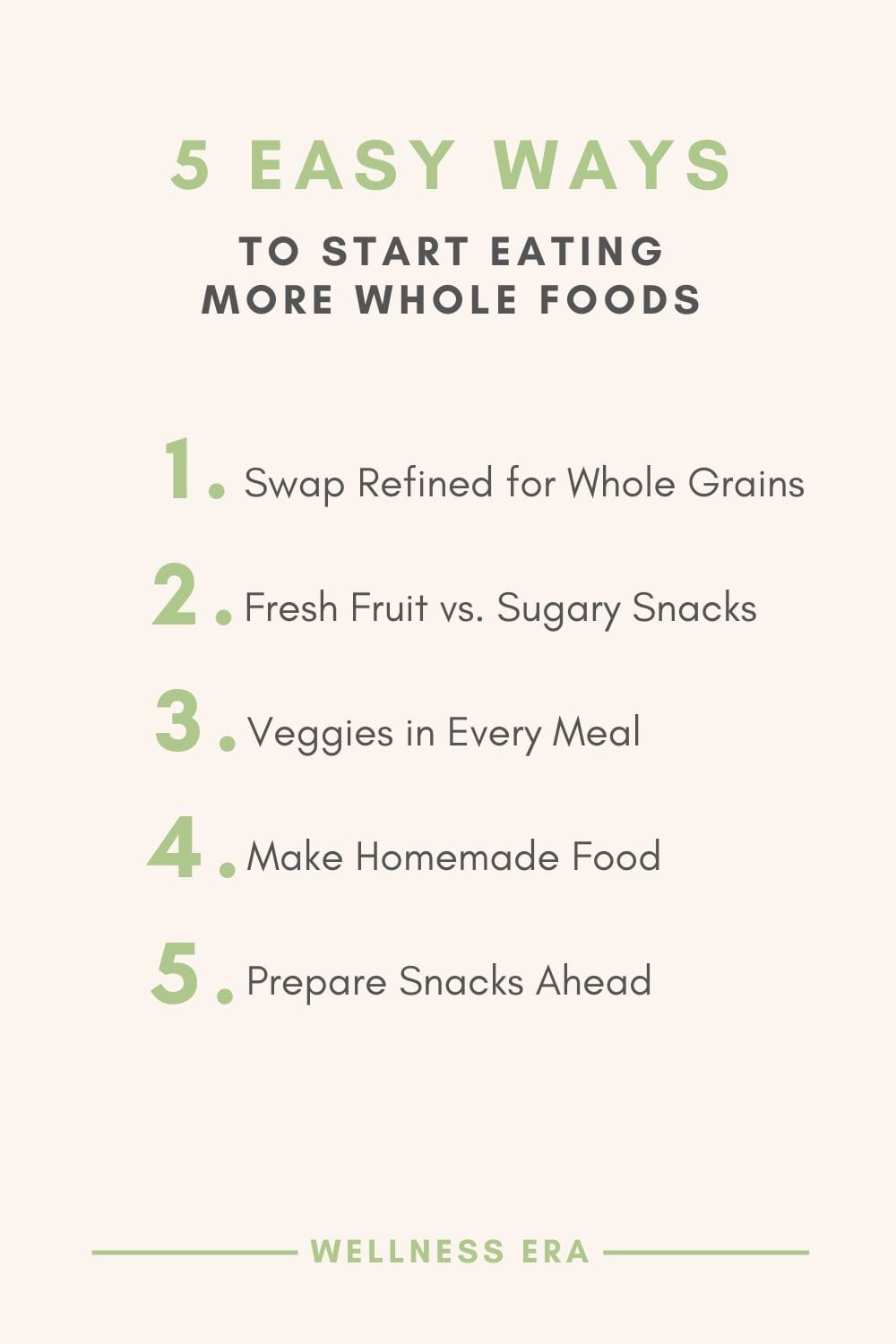
6. Can I Still Eat Whole Foods if I’m Busy?
Absolutely! Whole foods don’t have to be time-consuming. Meal prepping, buying pre-washed veggies, and making simple meals with just a few ingredients can save time. Slow cookers, sheet pan meals, and stir-fries are great ways to prepare whole food meals with minimal effort. The key is planning ahead—having whole foods on hand makes it easier to avoid processed snacks.
7. Are Whole Foods Better for Weight Loss?
Whole foods can support weight management because they’re typically lower in empty calories and higher in fiber, which helps you feel fuller longer. Unlike processed foods, which often cause blood sugar spikes and crashes, whole foods provide steady energy, making it easier to control your appetite and maintain a healthy weight.
8. Can I Still Eat Whole Foods on a Budget?
Yes! Whole foods don’t have to be expensive. Some of the most nutrient-dense whole foods, like beans, lentils, oats, and in-season fruits and vegetables, are affordable. You can also save by buying in bulk, purchasing frozen produce, and shopping at local farmers’ markets. Planning meals and buying what you need can help stretch your grocery budget.
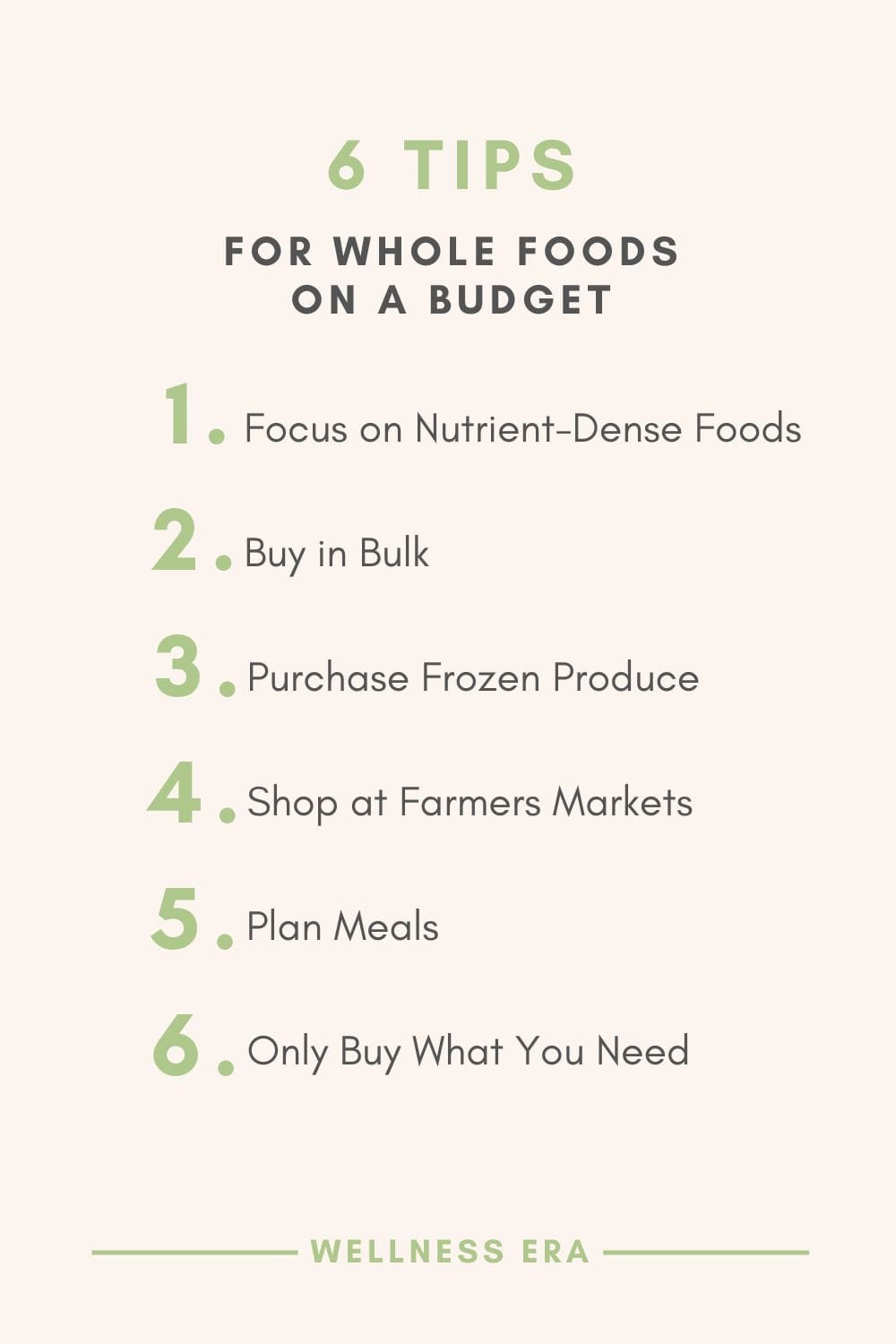

References
Smith-Spangler, C., Brandeau, M.L., Hunter, G.E., Bavinger, J.C., Pearson, M., Eschbach, P.J., and Bravata, D.M., 2012. Are organic foods safer or healthier than conventional alternatives?: a systematic review. Annals of Internal Medicine, 157(5), pp.348-366.
10. Conclusion: Start Your Journey to Wellness Through Whole Food Nutrition
Whole food nutrition is more than just a diet—it’s a lifestyle that nurtures your body, mind, and overall well-being. By choosing whole foods, you're investing in your long-term health, supporting vibrant skin, better energy levels, a strong immune system, and a reduced risk of chronic diseases. The benefits of this simple yet powerful change extend far beyond today; they will help you thrive for years to come.
The best part? You don’t have to make drastic changes all at once. Start small by incorporating more whole foods into your routine, making mindful swaps, and embracing the idea that the food you eat should nourish your body, not just fill it.
Ready to take the next step on your wellness journey?
I invite you to sign up for the Natural Wellness Foundation – Whole Food Nutrition Essentials QuickStart Guide, where you'll find everything you need to begin eating for wellness. This comprehensive guide includes:
The Body’s Need for Nutrition: Learn how your body and organs actually work and react to nutrients, and why whole foods are so essential.
The Truth About Processed Food vs. Whole Foods: Get a deeper look into the different types of processed foods, and understand the real impact they have on your health.
Building a Whole Food Routine: Discover what food elements and nutrients make up the perfect whole food nutrition routine.
Complete Whole Food Nutrient Guide: A full list of ingredients you should include and avoid for optimal health.
Considerations for Different Body Needs: Learn how to tailor whole food nutrition to your unique body and lifestyle.
Quick Reference Checklist & Shopping List: Practical tools to make your transition to whole foods easier and more efficient.
This guide is designed to make whole food nutrition simple, approachable, and achievable, no matter where you’re starting from. Whether you’re looking to transform your skin, improve your energy levels, or protect your long-term health, this QuickStart Guide will provide you with the tools you need to succeed.
Sign up today to download your free guide and start your journey to wellness through whole food nutrition. Your body—and future self—will thank you.
Would you like to receive something special?
Try out the best, inspirational weekly newsletter for your natural wellness era!
My Wellness Era Weekly
SUBSCRIBE TO OUR NEWSLETTER
Your Weekly Dose of Natural Wellness
Fill out the form below, and you will reveice "My Wellness Era Weekly" delivered to your inbox.
What you can expect: a short, warm, and personal note from our founder. Mindset shifts, journal prompts, or self-care reminders. Inspiring quotea related to wellness, mindfulness, or self-love. Small, actionable wellness habits you can try. Recomendations we love, are testing, or recently discovered. Highlights of our latest blog posts.
+++ What we’re loving every single week.
QUICK LINKS
SOCIAL
CATEGORIES



